|
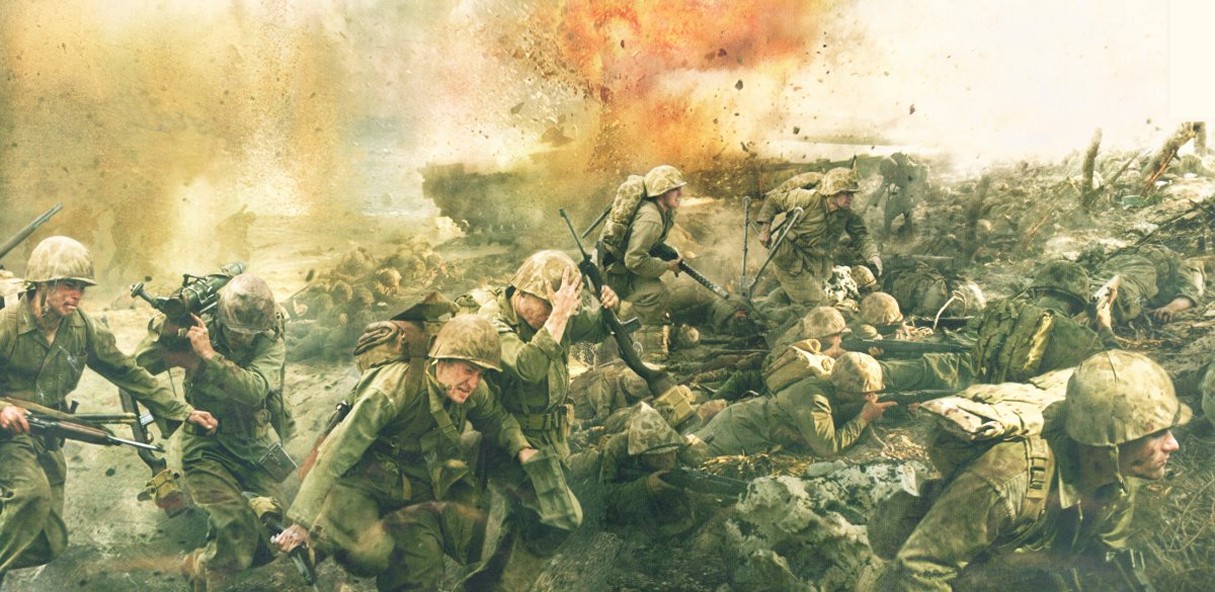
Rick Archer's Note: Who
would you name if someone asked you what man was most
responsible for ripping the first hole in Hitler's
formidable Atlantic Fortress on D-Day? In case you
draw a blank, his name is Joseph Dawson. The word 'Unsung
Hero' was coined with men like him in mind. Joseph
Dawson was the man who
eliminated the single greatest obstacle to success at Omaha
Beach on D-Day.
|
"Captain Dawson's combat experience proved invaluable
when his company landed on fiercely contested Omaha Beach.
He guided his men through an unmarked gap in a minefield,
assaulted and seized formidable enemy positions, and was
among the first to climb the bluffs overlooking the beach."
The American strategy at Omaha Beach
was to attack the German defense units with a frontal
attack. Unfortunately, by going straight into the
teeth of the German defense, 2,000 men met their death that
day. So how exactly did the Americans finally succeed?
To tell the truth, they almost failed. There was a
point during the early fighting where General Omar Bradley
concluded that Omaha Beach was a lost cause. So how
did they break through against all odds?
|
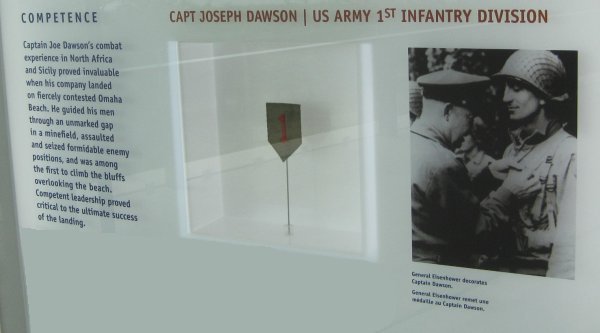 |
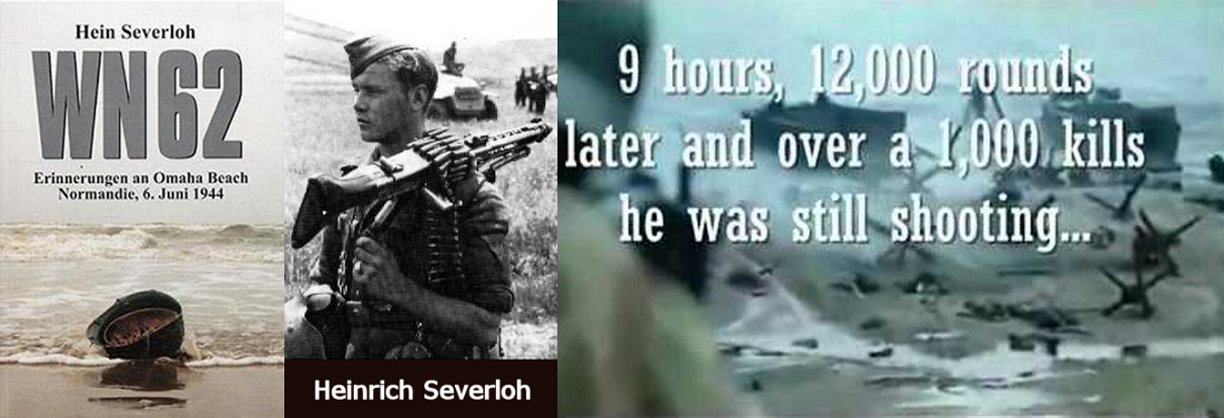
Joseph Dawson
was fortunate for two reasons. He was fortunate not to
come first. The men who came before him were now
victims. Dawson was also fortunate to land his company on the
only part of Omaha Beach that was relatively safe from the
withering gunfire of German soldier Heinrich Severloh. Better
known as the Butcher of Omaha, Severloh wrote
a book to claim he was personally responsible for
1,000 American casualties on that terrible day. While
historians still quibble over the exact total, let's just say
Severloh
earned his nickname.
The plan had
been to assault Severloh's position straight on.
Before Dawson's company landed, many brave U.S. soldiers had
tried to follow orders only to fall victim. Seeing the
nearby beach strewn with corpses, Dawson noted the utter
hopelessness of continuing to attack Severloh's position the
same way. He
decided to
improvise and take a different route up the bluffs. At
the top of the bluff, Joseph Dawson
took out a deadly Nazi machine gun nest with a desperate do-or-die
throw of two hand grenades. As the Germans
attempted to swing their gun around, a fraction of a second
determined who would live and who would die. Thank
goodness Dawson had a good throwing arm. This dramatic moment created the
very first opening of the day on Omaha Beach.
|
 |
It isn't that
Dawson's accomplishment has been completely neglected. Far
from it. His deeds are noted at the American D-Day
Museum at Normandy. In fact, this is how I first
learned his name during my visit on a 2010 cruise trip. I was so impressed, I took a picture
of Dawson's biography and researched his accomplishments
when I returned to Houston, Texas, my hometown. So what did I
learn during my research?
Captain Dawson was
not merely 'among the first to climb the bluffs' as
his bio states. Get rid of the word 'among'.
Joseph Dawson was without a doubt
the first MAN to
reach the top of the bluffs.
So what has kept
Dawson from getting full credit? Here is my theory.
Severloh was invulnerable from the front, but poorly
defended from behind. What Dawson was did was create
the first safe way to the top of the bluffs. However,
once there, Dawson did not take out Severloh himself.
His orders were to head directly to a nearby town known as
Colleville. Fortunately, for the rest of the day American units
were able to
use this route to get safely to the top. Sensing that
GI's were preparing to
attack Severloh's position from behind, the Germans
surrendered without a fight. Perhaps this disconnect
explains why it took historians so long to realize Severloh
would not have been neutralized so easily without Dawson's heroic
action in the first place.
|
In addition to
helping eliminate Severloh, Dawson's actions
allowed Philip Streczyk
to reach the top safely moments later. Like Dawson, Streckzyk was a remarkable hero. After taking
advantage of Dawson's safe route to the top, Streczyk pretty much single-handedly
took out a defense unit known as WN64. Since this unit
was cleverly concealed inside a dense forest on the side of
a hill, it was impossible to spot from the air. WN54
consisted of a dozen underground bunkers connected by
underground tunnels. Due to the heavy noise of
artillery fire, Streczyk was able to use the corridors to
sneak up on one bunker at a time. Thanks to the
element of stealthy and surprise, Streczyk eliminated the
enemy in brutal hand-to-hand combat, then moved onto the
next bunker. Streczyk is
credited as the man who caused the first German Resistance Unit of the day
to fall.
When I first
published my story on the Internet in 2011, I was surprised
to see my article achieve a certain level of fame. Over
the past years since, countless people have written to thank me for
focusing a spotlight on Captain Dawson's incredibly important
accomplishment. Here are a couple of examples.
From:
Randy Brandt
Sent: Thursday, March 26, 2020 1:25 PM
To: dance@ssqq.com
Subject: Omaha Beach
Hello Rick,
I ran across your stories today and was very impressed.
I have been leading military history tours to Europe
since 2015, so the beaches of Normandy are always part
of that. Thanks for all
of your research and documentation. I will certainly
talk of Joseph Dawson and the others next time I'm able
to go. There are always
more stories to learn!
Thanks again for sharing
your insights!
Randy
...............
From: Susanna Lemoine
Sent: Sunday, December 20, 2020 10:41 PM
To: rick@ssqq.com
Subject: D-Day
Hi Rick,
I just read your article about D-Day and discovered
something so enlightening about my grandfather. His name
is mentioned in the interviews, Sgt Joseph Barr. He was
the man who captured 8 German/Polish soldiers in a
dugout. Also, he was one of the few men who survived
Omaha beach and helped make that first hole in the
German line with Capt Dawson. He
went on with Dawson all the way to The Battle of the
Bulge, came back to Louisiana, married a beautiful
woman, and had 7 sons and 1 daughter. He
lived to the ripe old age of 92, dying on Christmas Eve
2011. He was highly decorated in WWII, I’m not sure of
all of the metal he received, but there were many,
including a silver star and two bronze stars.
I just wanted to touch base with you on this subject.
My maternal grandfather also fought on D-Day, but
I know less of his story, unfortunately.
Thanks to you. I discovered
today that my dear Paw-paw was even more of a hero than
I’d before thought. I am
blessed beyond measure. Thank you so very much for your
research and writings. It means so much to see his name
mentioned.
Sincerely,
Susanna Lemoine
.............................
Previous to my article,
Captain Dawson had
been the unsung hero of the day. Fortunately, based on
the letters I have received, I
believe my article has brought much-needed attention.
Perhaps the day will come when Joseph Dawson becomes a
household name.
Have you ever
heard of a back-handed compliment? That is when you
are complimented and insulted at the same time.
Indeed, my
article led to a very peculiar compliment. You see, by profession I am a dance
teacher. What do dance teachers know about military
history? A man who knew me through the
Houston dance community read my article and
forwarded it to a leading military expert.
|
Here is what
John Rivard said:
"Stan, I would appreciate
your review of the rather interesting website linked
here. It is written by a local Houstonian whom we
know from dancing. After reading what he has
prepared on the D-Day experience, you can also find a
link to his bio that explains who he is, a totally
unlikely person to have prepared such a piece.
He explains how he did it all with research. I
found the charts and photographs to be quite worthwhile,
along with the story of unsung heroes that we have not
heard about before. It would appear that
Cornelius Ryan, author of The Longest Day,
did not fully understand the significance of the
Dawson/Streczyk Omaha Beach invasion accomplishment."
On a personal
note, when I first published my article, I expressed the hope that my
story would someday bring fame to the two American heroes who
turned an almost certain defeat at Omaha Beach
on D-Day into triumph. Although various authors had
mentioned the names of Joseph Dawson and Philip Streczyk, at
the time of my 2011 publication it seemed no one had adequately covered the incredible
details of what these two men did.
I am pleased to
say I got my wish when I
revisited Omaha Beach in 2018. This time I discovered
a sign written in French on the path down to the sea: "Route
du Capitaine Joe Dawson".
I believe my story inspired someone to correct this oversight.
Seeing this tribute to Captain Dawson made it all worthwhile. And now I invite
you to read an
amazing story about courage and heroism against all odds.
Rick Archer
February 2025
|
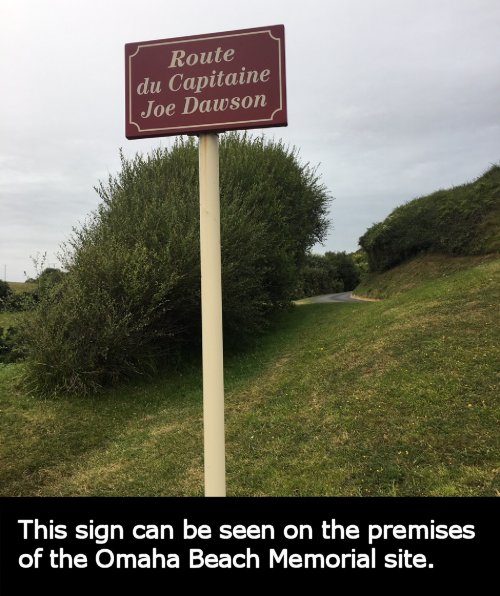 |
|
|
|
D-Day!!
Written by Rick Archer
June 2011
One day my daughter Sam noticed I was
watching The Longest Day, the famous movie about the
Normandy assault. She was 11 at the time.
Curious, Sam watched the TV for a while.
Horrified by the violence, Sam asked me a question.
"Dad, what does D-Day stand for?"
"What do you think it stands for?"
"Uh, does it stand for Death Day?"
I smiled. "That's a good answer."
This cemetery next to the infamous Omaha Beach holds 10,000 graves. D-Day indeed.
|
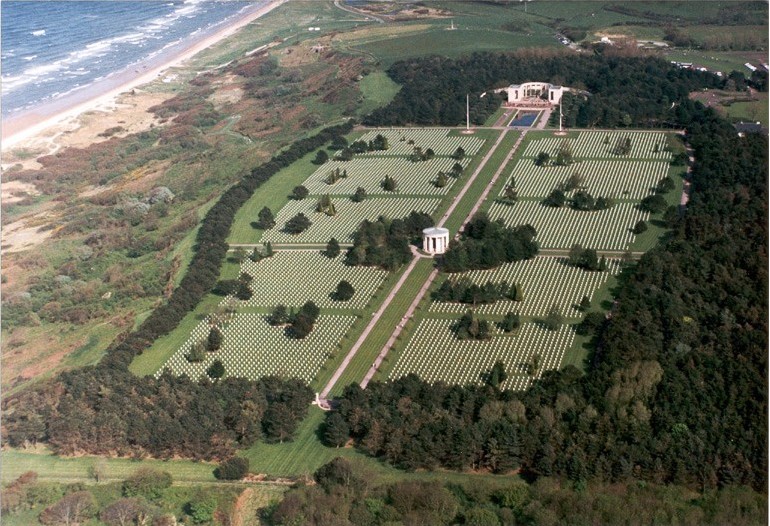 |
|
|
|
|
As I was growing up, I
always thought "D-Day" stood for "Decision
Day". However, after checking it out, I learned that General
Eisenhower clarified the meaning. He called it
"Departure Day", the day the ships depart to begin the
attack.
Every amphibious
assault - including those in the Pacific, in North Africa, in
Sicily and Italy - had its own D-Day. However, for most
of us, D-Day will always refer to the most
important battle of our lifetime, the Normandy Landing on
June 6, 1944.
I was born in
1949, a prime Baby Boomer year. World War II was over
and the world had settled into the Cold War Era. With
the notable exception of Korea and Vietnam, the Cold War Era was more about
the threat
of conflict than actual fighting.
Since there were no wars even remotely rivaling the
scope of World War II, I never had the privilege to serve in the military.
|
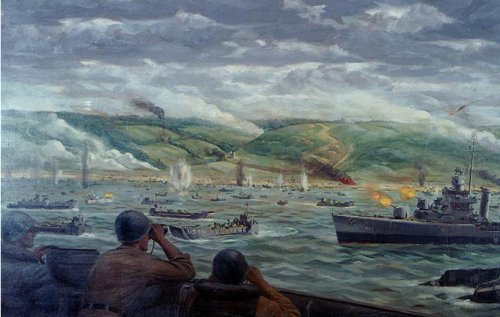 |
|
|
|
My father saw
brief action in the latter days of World War II. Dad was 19.
He was part of a
large force of reinforcements that had just arrived from the States
to give the war-weary veterans some relief. Unfortunately....
or fortunately depending on how you look at it... my father was shot in the hip
by a sniper while on patrol. This occurred just before the Battle of the
Bulge, the last major battle of World War II in December 1944.
Dad showed me the huge
scar on his hip. Then he surprised me by saying that injury was the
luckiest thing to ever happen. He had only been in
Europe for a week when he was hit. While Dad recuperated in the
safety of a hospital, many of the men in his company were killed
during the ferocious winter fighting at Belgium's Ardennes Forest.
The Battle of the Bulge
was Hitler's last ditch gamble. Despite its early success due
to the surprise attack, once the weather cleared, Allied air power
was able to push the Germans into a major retreat. Five months
later, the war was over.
While he was
recuperating, my father had the opportunity to talk to some of the
men who were still recovering from wounds suffered during D-Day the
previous summer. To a
man, they agreed this attack was terrifying beyond explanation.
Almost everyone had been certain there was no chance they were ever going
to survive.
How in the world were they supposed to cross those
barren beaches with thousands of machine gun bullets peppering the
air from the bluffs above? How were they supposed to scale
near-vertical hills without being hit? How were they
going to cross unmarked minefields without being blown to pieces?
Consequently the night before the attack every man had written a
final
letter to be sent to their wife or girlfriend and their parents in case
they didn't make it back. The guys my father talked to
obviously were among the ones who survived, but every one of them
saw dozens die right beside them that day. In the hospital, every man
had a bad case of 'Survivor's Guilt'. Why did the guy next to
them die while they were spared?
The Fates were indeed
fickle that day. Some unlucky paratroopers landed in the middle of a German
company at St. Mere Eglise. These men were shot to death
in the air before they ever landed. Yet other paratroopers landed in
deserted cow pastures. During the daylight
assault, 2,000 men died at Omaha Beach while 14 miles away only 200
Americans died landing at Utah Beach. Doesn't seem fair, does
it?
|
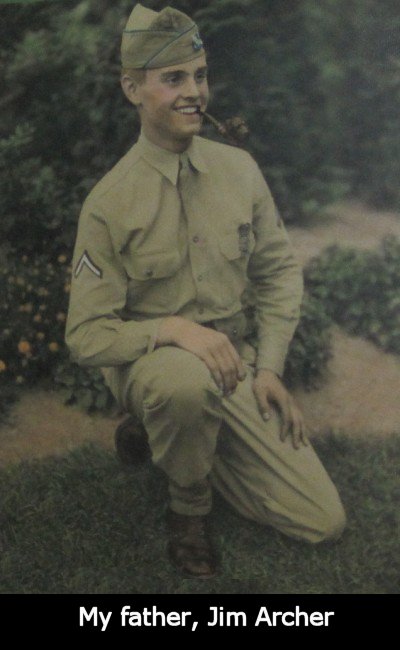 |
After listening to some of my father's stories about the
bravery of the men who risked their lives, I began to suffer from a
sort of survivor's guilt myself. I have lived a long, ultra-secure life because an army of teenagers had the
guts to fight for freedom 70 years ago. How is it
fair that I have never seen action while so many unfortunate
men died young that day?
I have long
wondered why they always send in kids to do the fighting.
That doesn't seem right. The young men have their
entire life to lose before they even get started. Interestingly, I
found comments on this exact question. Stephen Ambrose
in his book D-Day said,
"Inexperienced troops are often preferable to veterans.
For a direct frontal assault on an enemy position such
as D-Day, men who have never seen what a bullet or land
mine or exploding mortar round can do to the human body
are preferable to men who have seen the carnage.
Men in their late teens have a sense of invulnerability.
Their zeal and daredevil attitude far outweigh their
combat inexperience."
|
I sometimes
wonder why they
don't send old guys like me lumbering across that beach.
I know a lot
of men my age would be more than willing to go to war if
another monster like Hitler threatened our country.
Nothing could possibly be more important than stopping a man
like that.
Marv Levy was a
football coach who took the Buffalo Bills to four
consecutive Super Bowls. One year he was asked if he
was facing a 'must-win' situation in the upcoming Super
Bowl.
Levy, a World War II veteran, just smiled.
"World War II was the only
'must win' situation I have
ever been associated with."
None of us want
to die before our time, but doesn't it make more sense to
send people in the sunset phase of their life into risky
situations than those with their whole life ahead of them?
Furthermore, some of the most committed people on earth are
those with a lifetime of experience. Old guys aren't
fast and we don't see too good, but if we believe in what we
are fighting for, guys my age... and gals too!... are
certainly tough
enough to fire a weapon.
One of my heroes
of D-Day is Teddy Roosevelt, Jr, son of President Theodore
Roosevelt. At
age 57, Roosevelt was the only General to go in with the first wave
at Utah Beach. His major contribution that day
was getting American troops and tanks directly into the
French countryside before the Germans could react.
Sadly, Roosevelt died of a heart attack one month later.
No doubt his demise was stress-related, but he did not care
because he was doing what he believed in. Roosevelt was awarded the Medal of Honor posthumously for his work.
His grave at the Normandy Memorial gives strong testimony to
my suggestion that old guys can contribute as well as the
young.
I deeply respect and admire
the men who charged into the face of death at Omaha.
Their sacrifice
allowed an entire generation of kids like me to enjoy a life of
safety. The
Greeks have their heroes from Thermopylae and the British
have their Royal Air Force, but to me, the brave men of Omaha are my all-time heroes.
|
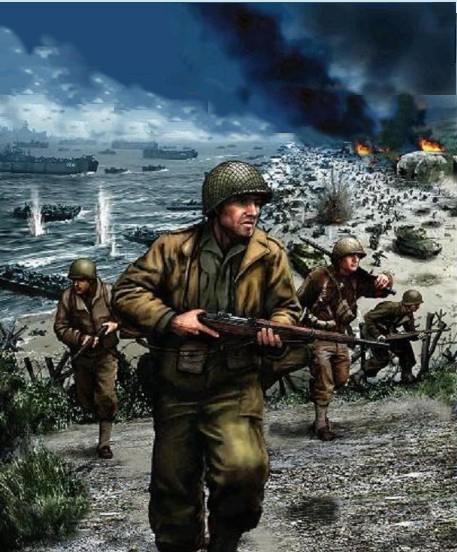 |
Cowardice and Courage
George Patton once said
that Courage isn't the absence of fear, but rather the
ability to fight in spite of one's fears.
One of the questions that has
haunted me my entire life is whether I would have the same
courage to fight at D-Day as the men who were able to
overcome their fears and still fight. My guess is that like
Patton suggested, I would be scared out of my wits, but
would do my best to force myself to act responsibly
nevertheless.
Still, until one is tested, one never knows, yes?
I am the perfect example. I have
lived 60 carefree years in the greatest, most secure country
on the planet. I have little
to worry about while people in other parts of the
world starve to death and die at the hands of tyrannical
governments.
As I write, I am 60 years old. I
spent 32 years running a successful dance studio, the
largest in the country at one point.
In my retirement years, I have spent over 10 years taking my
dance students on cruise trips around the world to
awesome places like Hawaii and Italy. When I am not
traveling, I spend my time in the comfort of my home writing stories about the places
I have visited.
Dancing. Traveling.
Writing. Can you imagine a softer, happier existence
than mine? No, of course not. But my story could have been far
different. A monster named Hitler came frighteningly
close to subjugating the world. If it hadn't been for
the brave men at Normandy, today I might 'spreche Deutsch' and
'lebe in Amerika'.
I am smart enough to understand the debt I owe...
the same
debt we all owe...
to the heroes of Normandy. This explains why I feel an overwhelming
gratitude towards the men who fought during World War II.
I am keenly aware that a
lot of good men died at D-Day so today's generations could
live in America safely.
So
how can I show my gratitude?
How can I somehow thank these men?
I decided there is one
thing I can do. I can help spread the word about the men
who are my heroes to a new generation. Following the grand tradition of
Homer's Iliad and
Tolstoy's War and Peace, there
is still a place in this world for bards, writers and poets
to sing praise to the glories and courage of our heroes.
So that is my motivation. Since
I enjoy writing, I
will retell the story of Omaha Beach because this is my
way to honor those brave fighting men of yesterday.
We all know the legends of the Spartans, Romans, and
Vikings. However, let us never forget that American
soldiers fighting in Europe and the Pacific proved time and
again that when called upon, Americans are
just as brave and just as bold as the celebrated warriors of
centuries past.
Rick Archer
June 6, 2011, the 67th Anniversary of D-Day
|

Background on the Story
of Omaha Beach
|
Rick
Archer's
Note:
I have written a
Short Version and a Long Version of the Omaha Beach saga.
This page is the 'Short Version'. If you enjoy
the Short Version, I promise the 'Long Version' is
equally fascinating.
I owe a debt of
gratitude to Google Earth. Through the
miracle of Google Earth, I was able to create
maps to illustrate my
story in a more concise way.
Prior to D-Day,
the Allies did everything in their power to maintain the
secrecy of their intended D-Day landing point. The
French town of Calais was considered the
likely target for the Allied invasion.
Lying a mere 20
miles off the coast of England, Calais was
looked at. However, the Germans had Calais
so heavily fortified that the Allies decided
Normandy offered them a better chance of success.
|
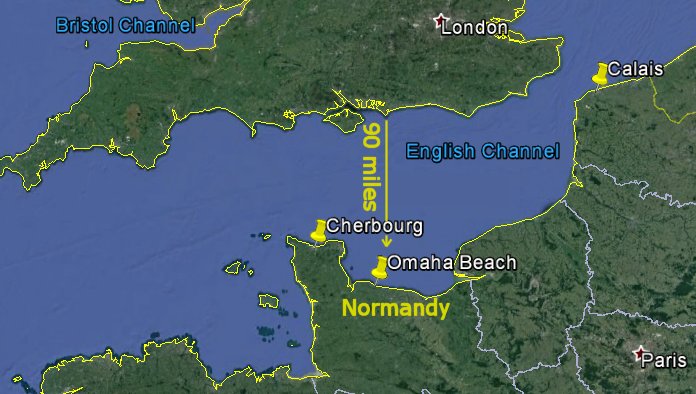 |
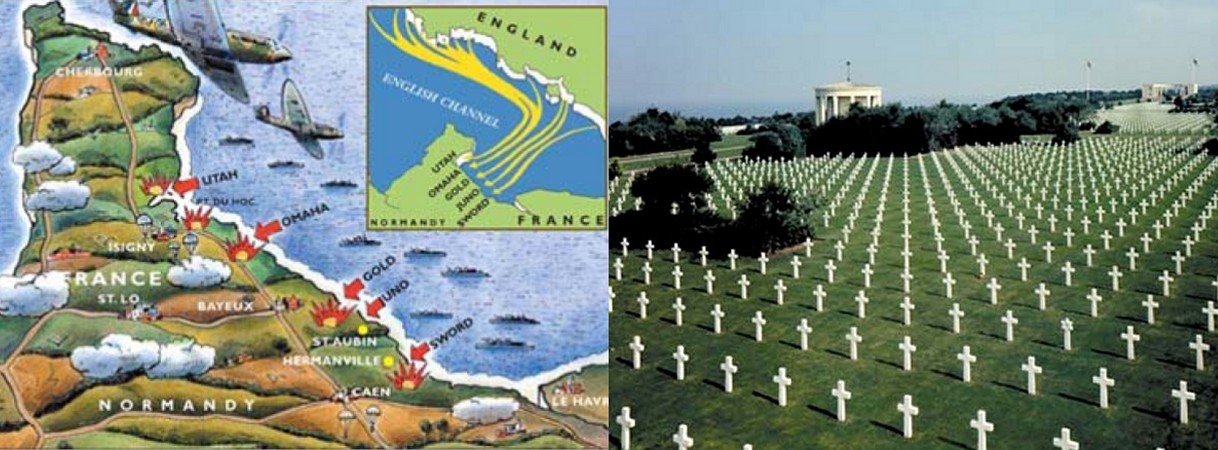 |
| |
At this point,
the Allies went to a serious amount of trouble trying to
deceive the Germans into thinking Calais was
indeed their objective. Meanwhile, Normandy
was divided into five sectors: Gold, Sword, Juno,
Utah, and Omaha.
Utah
and Omaha were assigned to the Americans.
Due to the difference in terrain, taking Utah
turned out to be a much easier task than Omaha.
As we shall see, the daunting hills, bluffs, and cliffs of
Omaha Beach turned the attack on this location
into a
horrible nightmare. 200 men died at
Utah Beach. 2,000 men died at
Omaha Beach.
In particular,
half of those men died trying to
take down the German stronghold known as WN62,
short for
WiderstandsNester, German for 'resistance nest'.
WN62 was notable because this is where
Heinrich Severloh, the so-called Beast of Omaha,
was positioned. Severloh, the
German soldier who manned a well-placed machine gun, is said
to have personally sent 1,000 men to their deaths.
Severloh's staggering death count explains why the American
cemetery is located where it is today... his victims were buried at
the nearest available spot.
Our story
revolves around two men - Joseph Dawson, Philip Streczyk.
Their decision to bypass Severloh by taking a different
unplanned route up the hill is what provided the day's first
Breakthrough.
|
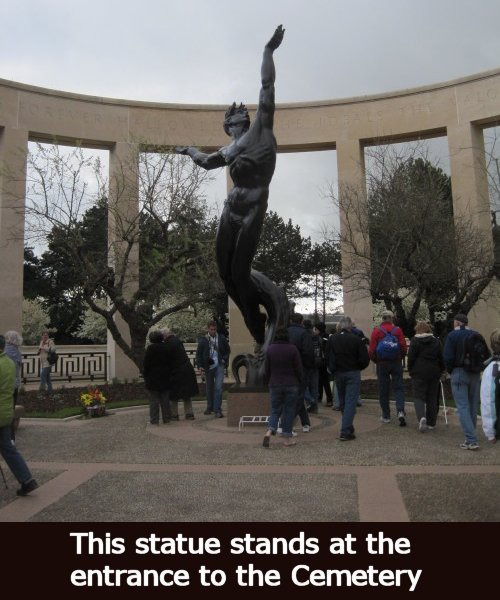 |
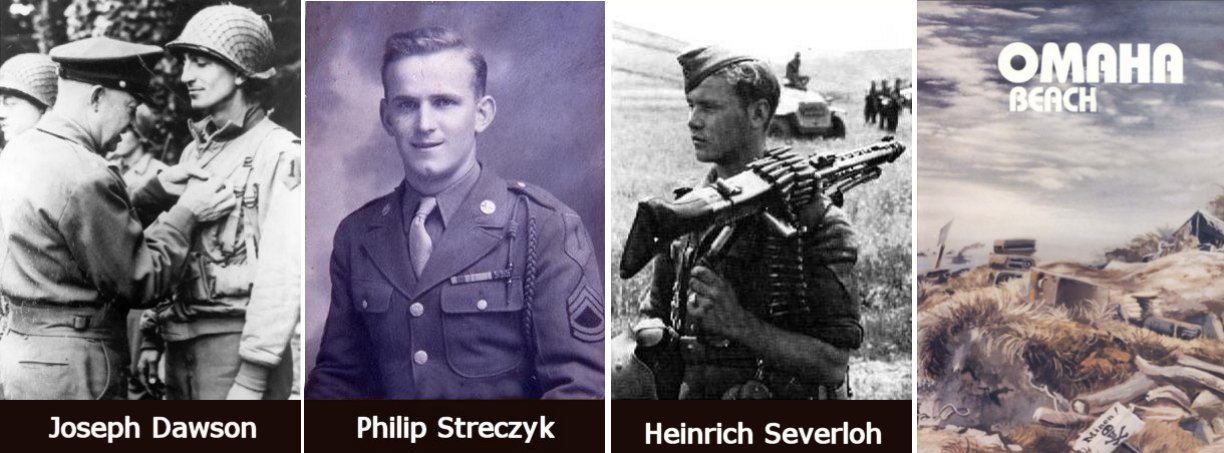
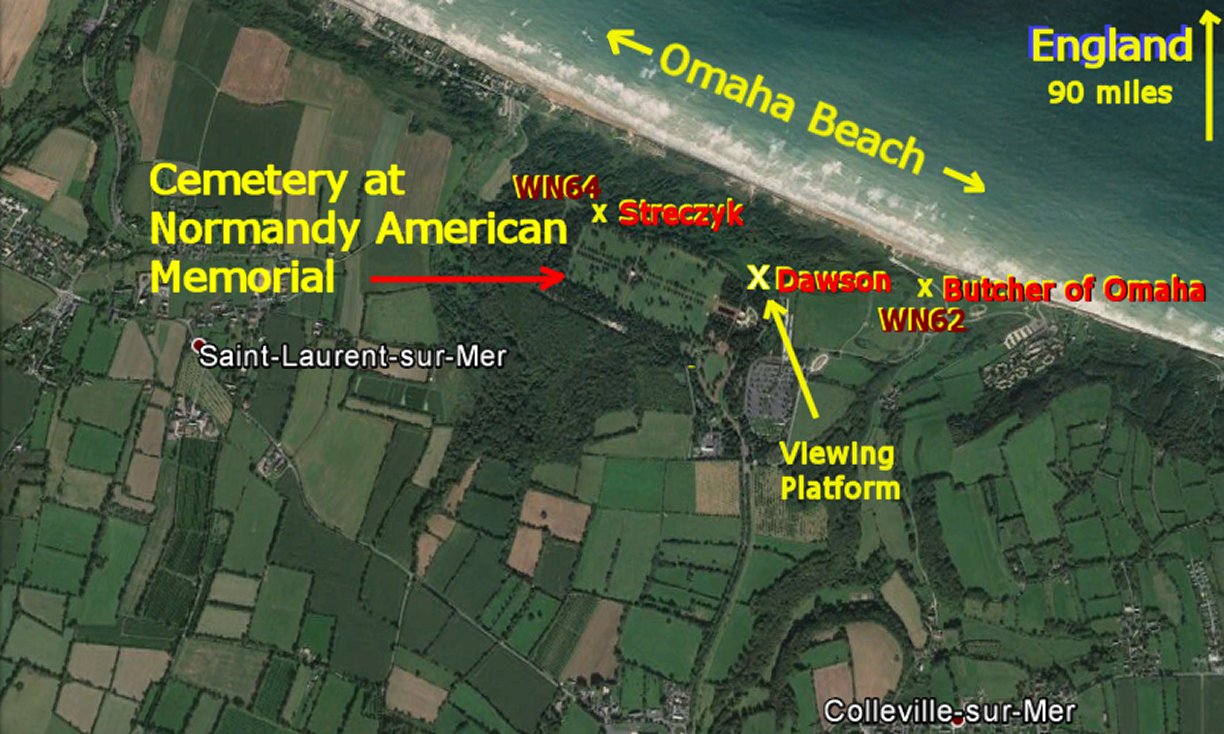
Rick
Archer's
Note:
I have a
fascinating secret to share. The Viewing Platform
at Omaha Beach is virtually the
identical place where Joseph
Dawson took out the German machine gun nest. As we
shall see, it is not a coincidence that the two locations
are side by side. I will explain why shortly.
Dawson's orders
had been to attack Severloh's position directly. One
look at the current body count on the beach signaled the
futility of that directive. So instead Dawson studied
the ravine directly in front of his landing point.
That ravine took Dawson to the spot identified as the
Viewing Platform.
Someday
you might get a chance to visit Normandy. If
you do, you will definitely want to
visit the Viewing Platform due to its importance as
the FIRST BREAKTHROUGH POINT in Hitler's Atlantic Wall. I have identified
the platform using the
Yellow X in the pictures
above and below.
In the picture
below, please note
Heinrich Severloh's position is listed as 600 yards from the
Viewing Platform. His powerful machine gun had a reach
of about 500 yards. In other words, one reason Dawson
and his company were able to climb the
ravine up the hill is because it was just barely out of range
of Severloh's deadly weapon. That said, they still had
to face the serious obstacles in front of them.
|
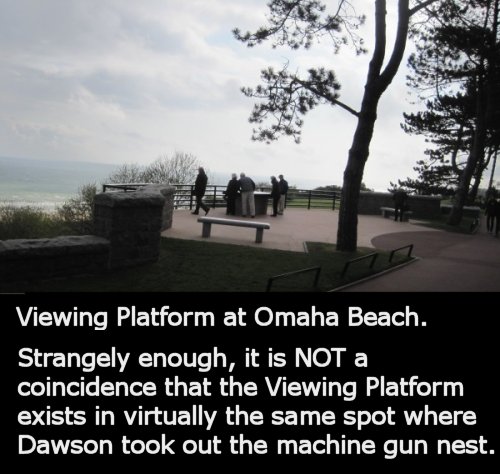 |
|
|
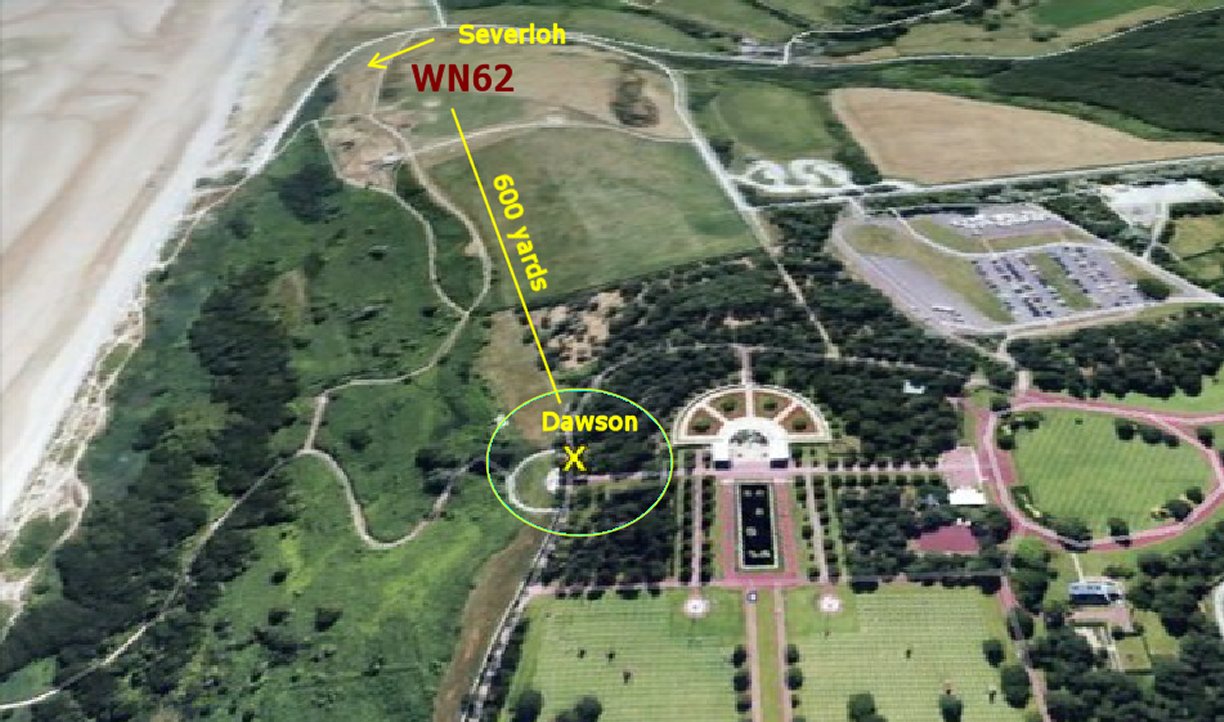 |
This
Yellow X
is the place where Joseph Dawson threw two hand grenades to
eliminate a Nazi machine gun nest at the top of the hill.
Due to his do-or-die
grenade toss, Dawson singlehandedly opened up the first safe
route to the hilltop on D-day at Omaha Beach.
This
was an incredible moment!!
And yet
as of 2010 there was absolutely not one statue or plaque to
memorialize the powerful significance of this location.
Consequently not
one visitor has any idea of the importance of this spot.
Once I learned the truth, I was very upset that nothing
existed to memorialize Dawson's heroic action. Indeed, thanks
to Joseph Dawson, the Americans made the 'Breakthrough' to
reverse an almost certain defeat into an amazing
victory. I hope
my story will someday change that oversight.
If you know someone in a position to address this issue,
please take action. Our children and our children's
children should be told the importance of this exact spot.
When I first
made my discovery, at first I thought it was an unusual
coincidence that Joseph Dawson made his 'Breakthrough'
at the exact same spot as the Viewing Platform.
However, as I learned more, I realized it was not a
coincidence at all. Heinrich Severloh was the reason
the two spots coincide. However, before I detail
how the Viewing Platform is connected to
Dawson and Severloh, let me explain how I happened to learn what
I did.
|
Cherbourg was
a major objective at D-Day. Cherbourg was a deep-water
port about 40 miles west of Normandy. One of the main reasons
for choosing Normandy as the landing point was its proximity
to Cherbourg. The Americans coveted this
port as the perfect spot to land supplies and reinforcements
sent from the USA onto Europe's mainland.
It was Teddy
Roosevelt Jr, son of President Theodore Roosevelt, who sent the Americans in a sprint to seize
Cherbourg the moment the soldiers landed at Utah
Beach. Unfortunately, the Germans knew full well the
potential of Cherbourg and had the city well-defended.
So the plan was attack Normandy first since it was a somewhat easier
target. After D-Day, it took a pitched two month
battle to finally dislodge the determined Germans from
Cherbourg.
|
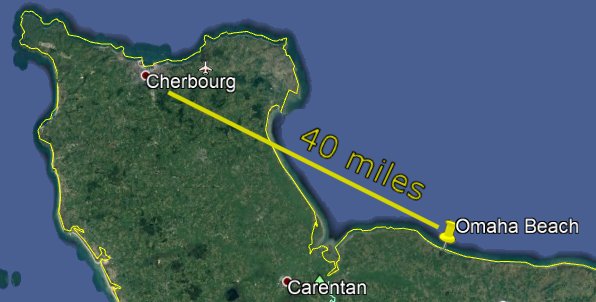 |
Today Cherbourg
is valuable for another reason. It is the
only port near the Normandy landings deep enough to handle
ultra-large cruise ships.
Cruise ships regularly dock in Cherbourg to allow visitors
like me to come see Omaha Beach, site of one of the
fiercest battles of World War II... with a nod of course to
other intense battles such as Iwo Jima and the Battle of the
Bulge.
My discovery
about the secret of the 'Viewing Platform' came about thanks to a cruise trip my wife Marla and I took to France in May 2010.
Our cruise ship landed at Cherbourg and then
I took a bus tour over to Omaha Beach.
I owe my pastime
as an amateur travel writer to my dear wife Marla.
Marla organizes several cruises a year for our group of friends and former dance students who live
nearby in Houston, Texas.
On
Sunday, May 9, 2010, I had the privilege of visiting the
Normandy American Memorial. This Memorial contains the
World War II cemetery in Colleville-sur-Mer, Normandy,
France. This site honors the many thousands of American soldiers who died
fighting in Europe
during World War II.
There were
twelve
people in our group that day. Sorry to say, the only
person who didn't get to see Omaha Beach was Marla. The poor
woman was suffering from a bad case of Norovirus, the
stomach bug that takes about 24 hours to pass.
In a way, maybe
it was better that Marla wasn't with me. In a very odd
way, Marla's illness contributed directly to my discovery.
I depend on Marla to keep me from wandering off too far when
I get curious about something. Without my
constant companion beside me, I was on my own all day.
By disengaging from
the group and the tour, I was able to cover more ground than any other
person in our group. I did this because I wanted to see as much of Omaha Beach as I possibly could.
|
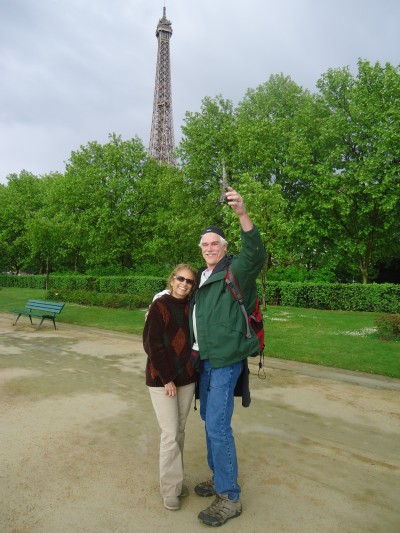 |
At the end of my
long loop around the grounds, I discovered the
Visitor's Center. This addition was completed in 2007. The first
floor was lined with pictures and biographies of men who
distinguished themselves at D-Day. I was incredibly moved by what I saw.
Twelve men received the Medal of Honor for their actions
that day. Unfortunately Dawson and Streczyk were not among
them, a terrible oversight in my opinion. Considering
the magnitude of this oversight, now we know where the
phrase 'Unsung Hero' comes from.
As I read the stories and realized the
kind of courage it took to accomplish their responsibilities,
I shook my head in astonishment. Unfortunately,
this wasn't the movies where everyone lives happily ever
after. I burst into tears as I read how brave heroes
such as John Pinder, Frank Peregory and Jimmy Monteith died
fighting in this bloody battle. It made me heartsick.
Things were even
tougher to handle downstairs. That is where I saw
videos about the men who fought that day. These
stories were so wrenching that I found myself filled with
tears. Trust me, I wasn't the only one crying.
Everyone down there was overwhelmed.
I am not ashamed
to admit I
ended up making a fool of myself. I don't wear a watch
nor did I have Marla to help keep me focused.
I ended up being 20 minutes late back to the bus.
Overwhelmed with tears, I became so oblivious to reality that I lost l track of time.
That's how bad it was for me... I was completely lost in
grief over the senselessness of it all. To lose brave
men this way was so difficult to accept.
|
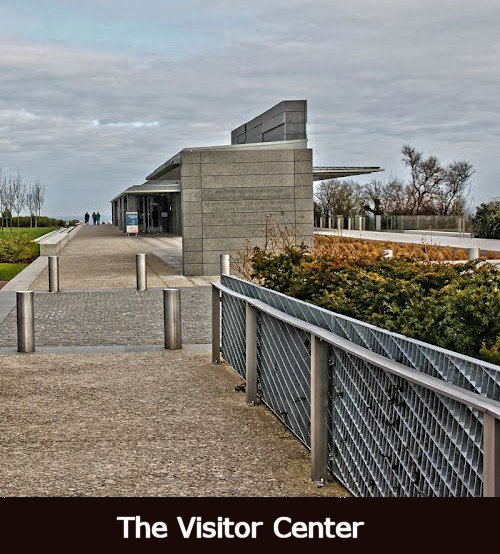 |
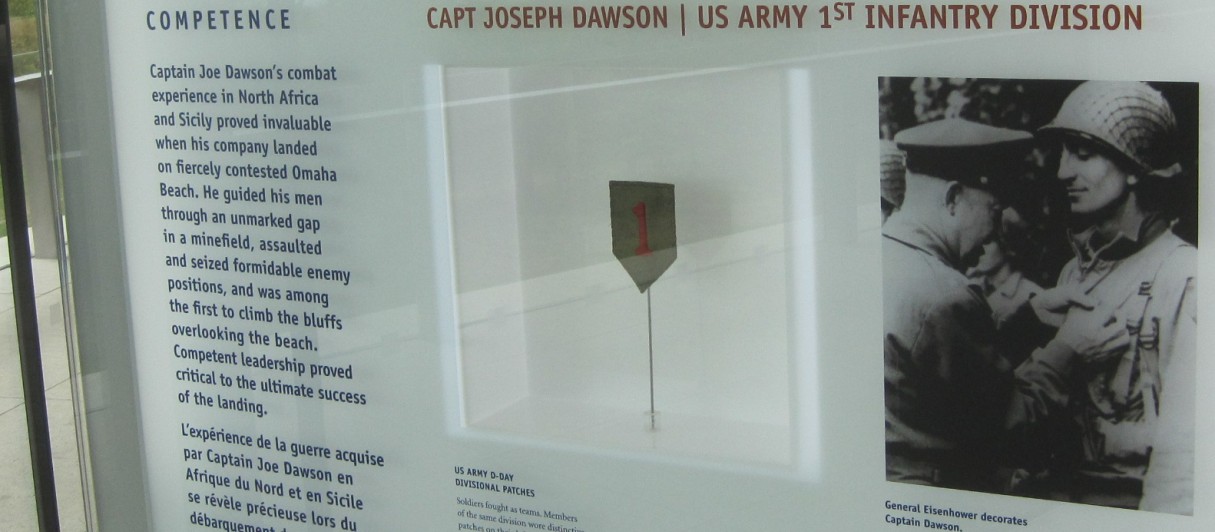 |
One of the men
featured at the Visitor's Center was Joseph
Dawson. Please note what
it says about Dawson in the picture.
"Dawson guided his men through an unmarked gap in a
minefield, assaulted and seized formidable enemy
positions, and was among the first to climb the bluffs
overlooking the beach."
This sentence hardly gives justice
to the immense contribution Dawson made that day.
This brief biography at the Visitor Center
does not even scratch the surface. I believe that is
because so far the historians never quite grasped the
significance back when the deeds were being chronicled.
Please keep in
mind that there were many American heroes at Omaha Beach,
but for some reason Joseph Dawson stood out in my mind.
Although I had no way to realize the importance of Dawson's
contribution during my visit, I found myself curious to know
more about him in particular. Why was Dawson 'competent'?
What exactly did he do?
When I returned
to Houston, I began to read. That is how I learned
that Joseph Dawson was the man who created the initial wedge
that broke the battle open. In fact, Joseph Dawson
likely played the most important role of the day in
turning the tide for the Americans. And yet few
Americans have any idea what Joseph Dawson did!!
|
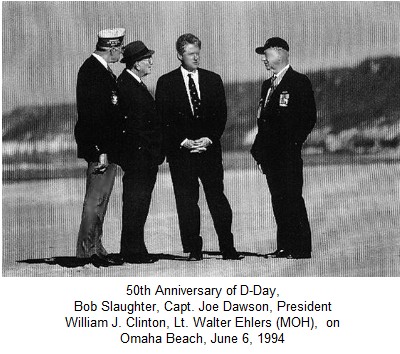 |
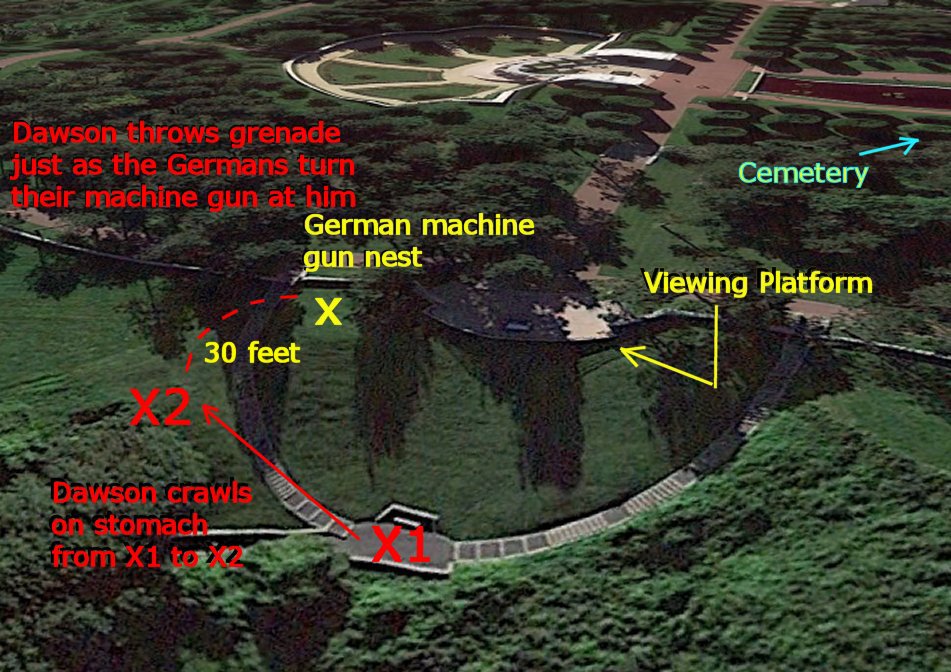
|
Now it
is time to explain why the Viewing Platform and Joseph Dawson's
grenade throw are virtually the same spot.
01.
On D-Day, Dawson and his men landed in what was
likely the only poorly
defended spot on the beach.
02. The spot identified as the Viewing Platform was
roughly 600 yards from water to the top of the hill.
03. Dawson's orders said to directly attack the
heavily-defended German Resistance Unit on his left
known as WN62.
04. Taking note of the massive body count to his
left due to Severloh's commanding position, Dawson decided a direct attack was futile.
05. Instead, Dawson thought a more promising route
was to explore the gully before him. Why not
try to climb to the top of the hill?
06. After treading carefully past the initial minefield, Dawson told his
men to wait for him at a midway point on the hill.
07. Taking one other man with him, Dawson
reconnoitered the terrain above.
08. Captain Dawson went with just one other man.
He did not want to
endanger his own men, so he choose to take the risk
himself.
09. Half the way up, Dawson and the other man drew
machine gun fire from above. They quickly dove to the
ground.
10. Dawson told the other man to go back down and bring
the rest of the company up to this spot.
11. At this point, another unit led by Lt.
John Spalding
and Sgt. Philip Streczyk appeared some distance away.
12. Using sign language, Dawson signaled Spalding to
distract the Germans above with intense fire.
13. While Spalding's company kept the Germans
occupied, Dawson crawled 100 yards on his belly and slowly made his way to the top.
14. Dawson
reached a giant outcropping directly below the machine gun nest
where he could not be seen.
15. From there, Dawson circled clockwise around the
large rock till he was about ten yards from the
Germans, but still unseen.
16. Just before he revealed himself, Dawson took the
pin out of two grenades.
17. The Germans saw Dawson when he stood up.
They desperately turned the machine gun at
him as Dawson hurled both grenades.
18. Dawson's throw was perfect. It not only
saved his life, it created the first 'Breakthrough'
of the day on Omaha Beach.
19. The path to the top was now open. Dawson
was joined at the top by his company and by Spalding and Streczyk.
20. Dawson's company continued south towards
Colleville while Spalding and Streczyk moved west to
search for WN64.
(To
avoid confusion, the machine gun unit eliminated by
Dawson and Severloh's machine gun location are not
the same.)
There is
a winding Walkway that allows visitors to walk down
from the Viewing Platform to the beach below if they
wish. During my 2010 visit, I took quite a few
photographs of the terrain surrounding this walkway
as I headed to the water. After
reviewing my 2010 photographs and comparing them to
military charts which detailed Dawson's movements, I
suddenly realized this zigzag Walkway was likely the
same route Captain Dawson took during his fateful
climb up the hill. In that case, I concluded
the Viewing Platform at the Normandy Memorial is located
in the same spot where Dawson took out the German
machine gunners.
That seemed like quite a
coincidence, so I
asked myself, "Is there a reason why
the Viewing Platform is located in
the same spot where Dawson's Breakthrough took
place?"
As I learned more, I realized it was not a
coincidence at all. My first clue was the
existence of the nearby Cemetery. My second
clue came when I realized Heinrich Severloh's deadly
killing ground was nearby. The position of
the Viewing Platform is the direct result of Heinrich Severloh's deadly machine gun
which had been located 600 yards to the east.
Struck
by a chilling thought, I suddenly realized that the
beach directly below was covered with 1,000 bodies
on D-Day. That is why the cemetery was located
nearby as the most convenient place to inter the
bodies. That also explained Dawson's route up
the hill. By taking the ravine, Dawson's
company was able to operate out of sight and out of
range of Severloh. But first they had to get
past a different machine unit located at the crest
of the hill right where today's Viewing
Platform is located.
|
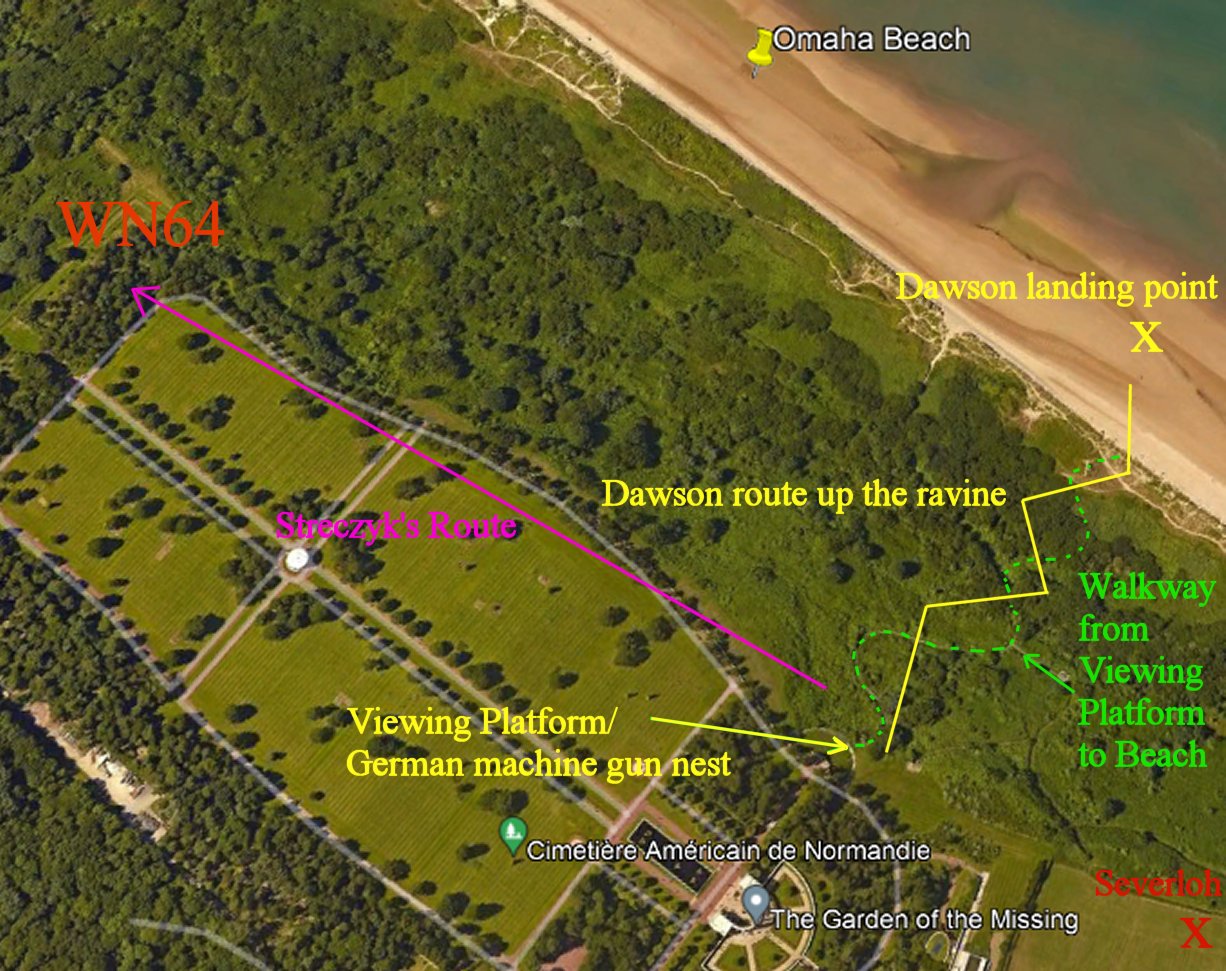
Heinrich Severloh, Butcher of Omaha
|
 |
Rick Archer's Note:
The powerful German Resistance Unit
facing Joseph Dawson's sector was known as WN62.
The cornerstone of WN62 was a well-placed
machine gun unit manned by Heinrich Severloh.
In a book written by Severloh after the war, he
claimed to have single-handedly killed 1,000
Americans at Omaha Beach. Military experts have concluded that Severloh
is likely correct. For this reason, Severloh
became known as 'The Butcher of Omaha'.
I do not
wish to demonize this man. In fact, I want it
to be known that in his book Heinrich Severloh expressed
extreme
remorse for his actions during this battle.
Let me share a 2004 interview from the
Washington Post.
"Severloh had taken up a concealed position on the
eastern side of the beach along with 30 other German soldiers,
and he recalls watching the horizon turn black with dozens of
ships and landing craft racing for the shore. His commanding
officer, Lt. Bernhard Frerking, had told him not to open fire
until the enemy reached knee-deep level, where he could get a
full view.
"What came to mind was, 'Dear God, why have you abandoned me?' "
he recalled. "I wasn't afraid. My only thought was, 'How can I
get away from here?' "
But rather than run, Severloh slipped the first belt of
ammunition into his MG-42 machine gun and opened fire. He could
see men spinning, bleeding and crashing into the surf, while
others ripped off their heavy packs, threw away their carbines
and raced for the shore. But there was little shelter there.
Severloh said he would occasionally put down the machine gun and
use his carbine to pick off individual men huddled on the beach.
He is still haunted by
the memory of a particular soldier.
The man was loading his rifle when Severloh took aim at his chest. The bullet went high and hit the
man in the forehead.
"The helmet fell and rolled over in the sand," Severloh said.
"Every time I close my eyes, I can see it."
Severloh said he was the last man firing from his position. By
mid-afternoon, his right shoulder was swollen and his slender
fingers were numb from constant firing. When a U.S. destroyer
pinpointed his position and began to shell it, he fled to the
nearby village of Colleville-Sur-Mer, where he was captured that
evening (probably
by Dawson's unit stationed there).
Severloh was fortunate to
leave when he did as several GIs who had circled
around from the rear attacked the WN62 position brief
moments after his escape, putting a decisive end
to the deadliest spot on the beach that day.
In Severloh's telling of D-Day, there are few heroes and several
surprises. The German occupiers had warm relations with their
French farm hosts before the invasion, he contends.
Lt. Frerking,
who died on D-Day, was an honorable man.
Severloh said
Frerking spoke fluent French and once
gave a man
10 days' punishment for failing to help an
elderly French woman with her shopping bags.
Severloh first told his tale to an inquisitive
correspondent for ABC News during the 40th anniversary of D-Day
in 1984. But the real breakthrough came when an amateur war
historian named Helmut Konrad von Keusgen tracked Severloh down.
Von Keusgen, a former scuba diver and graphic artist, said he
had heard from U.S. veterans about the machine gunner they
called the "Beast of Omaha Beach" because he had mowed down
hundreds of GIs that day. Severloh confessed he was that gunner.
Von Keusgen ghost-wrote Severloh's memoirs, published in 2000,
and still visits him regularly.
The two men contend that Severloh might have
killed or wounded
as many as
2,000 GIs. That's an impossible figure, according to German and
American historians, who say that although the numbers are far
from exact, estimates are that about 2,500 Americans were killed
or wounded by the 30 German soldiers on the beach.
"My guess is yes, he helped kill or wound hundreds, but how many
hundreds would be hard to say," Roger Cirillo, a military
historian at the Association of the U.S. Army in Arlington,
wrote in an e-mail. He added: "Omaha
Beach is like Pickett's Charge.
The story has gotten better with age, though no one doubts it
was a horror show. Men on both sides were brave beyond reason,
and this is the sole truth of the story."
Hein Severloh said he takes no pride in what he did, but telling
his tale has given him a sense of relief.
"I have thought about it every single day that God gave to me,"
he said. Now, he said, "The pressure is gone."
In my opinion, Heinrich
Severloh was a solider who was doing his duty.
He was ordered to shoot the enemy. Had he
refused, Severloh would have been accused of
cowardice and no doubt shot in the back by a bitter
comrade. The real villain of this story is
Adolf Hitler, not Heinrich Severloh. That
said, I will agree that Severloh was the major
nemesis of the day. Severloh was brutally effective.
|
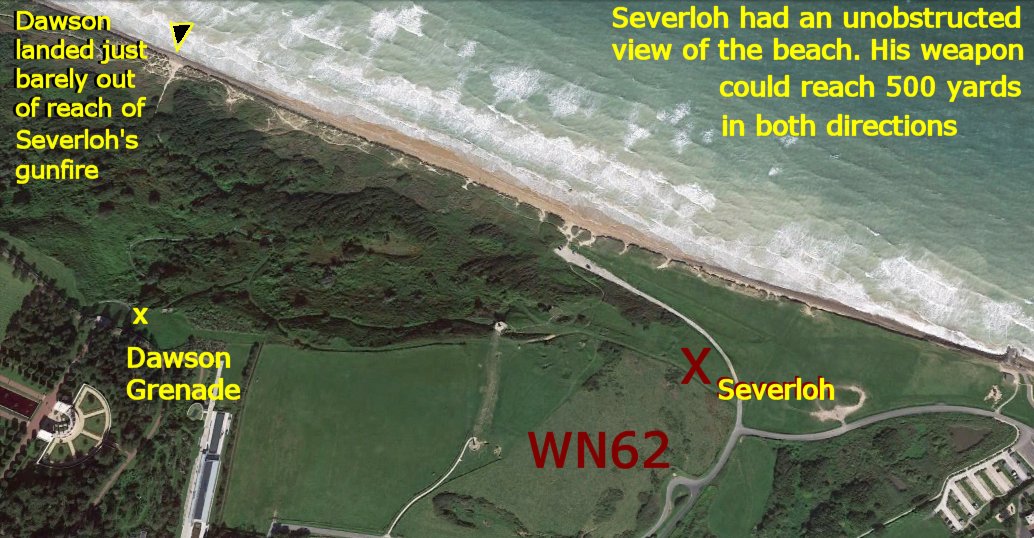
|
By
chance, Joseph Dawson landed just barely out of
reach of Severloh's deadly fire.
Once Dawson
saw all the dead bodies as well as the countless men
pinned down by Severloh's fire to his left, Dawson
was persuaded to 'improvise' and try a
different route. This decision explains why
Dawson's men lived when so many others died.
(Author's
note: the remnants of WN62's concrete bunkers can still
be seen today.)
|
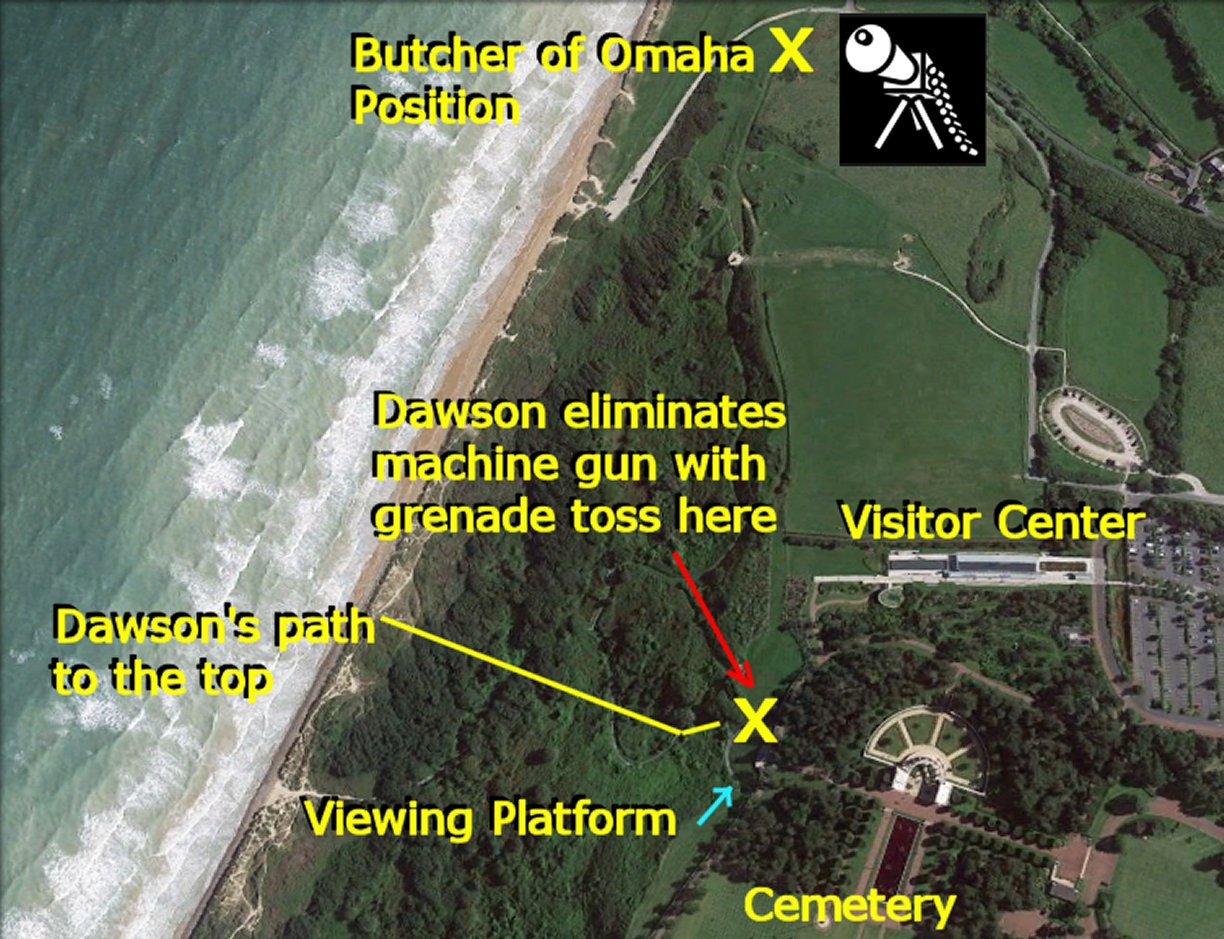 |
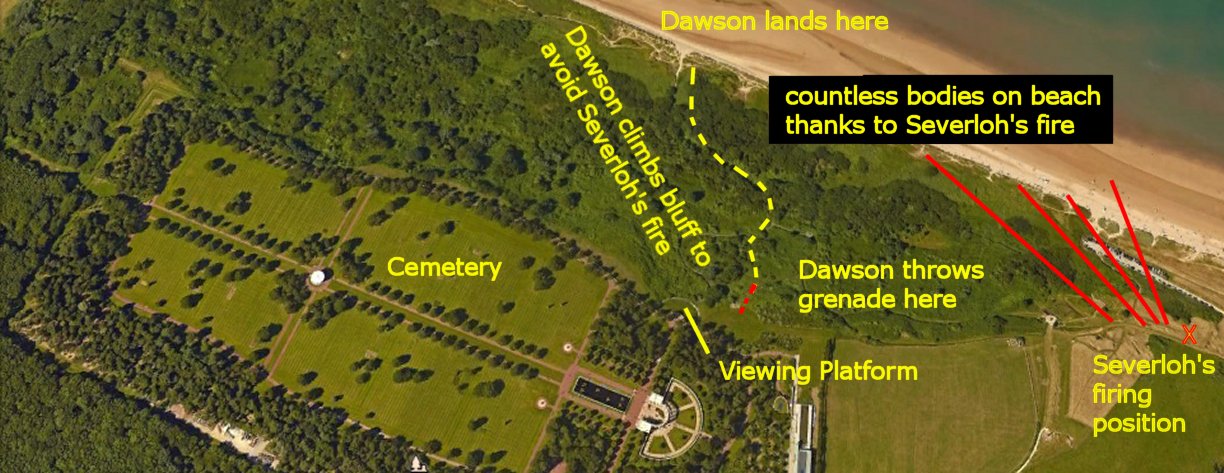
So what
about that Viewing Platform/Dawson
coincidence?
Heinrich Severloh
was the reason Dawson took the path that ended
exactly where the Viewing Platform is located today. Severloh's weapon had a range of 500 yards.
Dawson's unit was lucky to land in a spot 10
feet beyond the range of Severloh's deadly machine
gun. Although Dawson had been ordered to attack Severloh's position directly,
that looked like an invitation to suicide. Dawson
took one look at the gruesome number of mounting
casualties and realized following orders would ensure death for all his men.
Dawson decided he would rather try the funnel-like
ravine on the hill before him.
And what
about the Cemetery? Heinrich Severloh
is said to have gunned down 1,000 American soldiers
from his dominant view of the landing area. The
American Cemetery is located 800 yards from the
spot identified as 'Severloh's firing position'.
In total, 2,000 Americans
died at Omaha Beach at D-Day. This means that
due to Severloh, 50% of those casualties took place
in one spot.
Now we know why the
American Cemetery is located where it is...
this area atop the ravine was the most convenient place to bury all
those bodies. In other
words, Heinrich Severloh was the reason the American
Cemetery is placed where it is today. The sad
thing is without Joseph Dawson, the cemetery would
have had many more graves.
It was
Dawson's decision to disobey orders that turned
almost certain American defeat into victory on this
fateful day. Dawson's courage saved the lives
of countless men.
In my
opinion, Joseph Dawson deserved the Medal of Honor.
However Dawson was given the Distinguished Service
Cross instead. Personally, I believe the
battle was so complex that the full extent of
Dawson's contribution was not understood until well
after he had already been decorated. Fortunately,
over the years, Dawson has begun to receive more
credit. The ravine he climbed that day was
renamed 'Dawson's Draw'. At the 50th
anniversary of the D-Day landings, Joseph Dawson was
selected by the Army to speak at the ceremonies as
the representative of the troops who landed that
day.
|
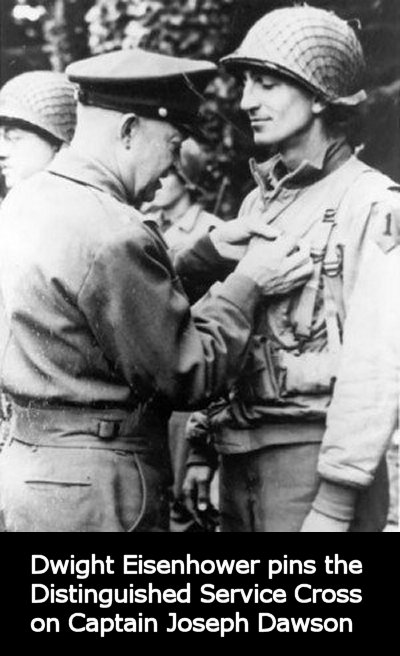 |
Introduction
to Joseph Dawson's Story at Omaha Beach
|
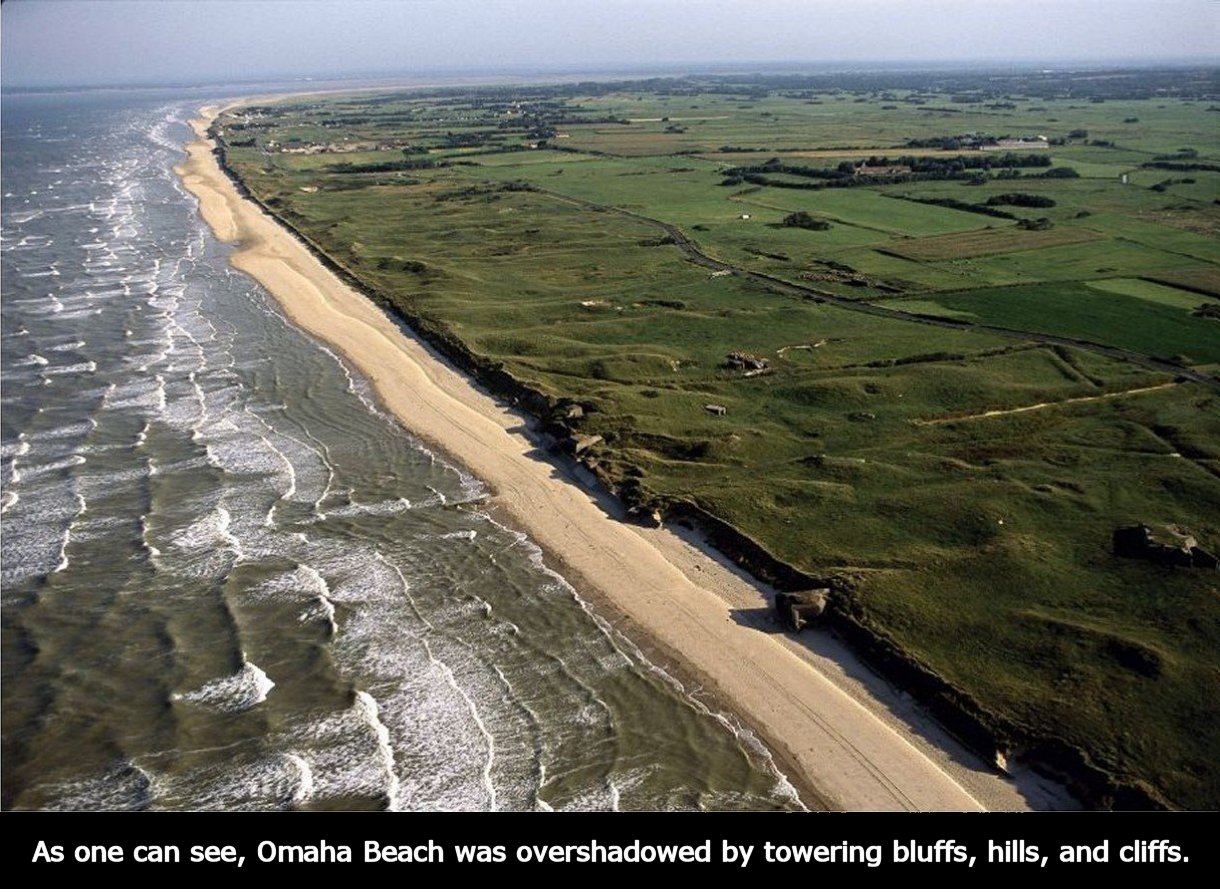 |
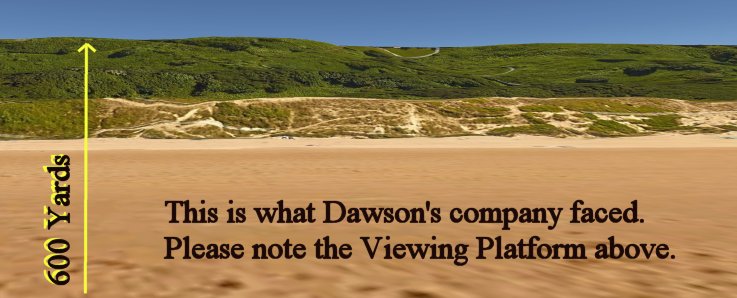
Rick Archer's Note:
Before I
start my story, I wish to point out you will be
reading an important piece of American
military history that has been largely overlooked.
Although I would hardly call myself a military
expert, after extensive reading I reached the
conclusion that Joseph Dawson is the man who turned
the battle around. It is my hope that after
reading my story, each Reader will reach a similar
conclusion.
The
American strategy at Omaha Beach was to attack the
German WN units with a frontal attack.
Unfortunately, by going straight into the teeth of
the German defense, 2,000 men met their death.
So how exactly did the Americans finally succeed?
To tell the truth, they almost failed. There was a
point during the early fighting where General Omar
Bradley concluded that Omaha Beach was a lost cause.
I
contend that Joseph Dawson was the first man at
Omaha Beach to penetrate the Nazi defenses and get
to the top of the hill. Once Dawson cleared
the area of machine guns, he created the first
safe zone on the entire Omaha Beach. For the
next hour, every incoming unit was directed to
follow Dawson's path up the hill, i.e. 'Dawson's
Draw'. This
breakthrough allowed the Americans to take out the
dangerous German WN62 unit from
behind. By creating the first SAFE
ROUTE TO THE TOP, Dawson saved countless lives.
I did
not get this idea from a
history text, but rather reached this conclusion
myself. If I am correct... and I believe I
am... my 2011 story became the first to directly
point out the full extent of Joseph Dawson's
contribution.
And now
to our story.
|
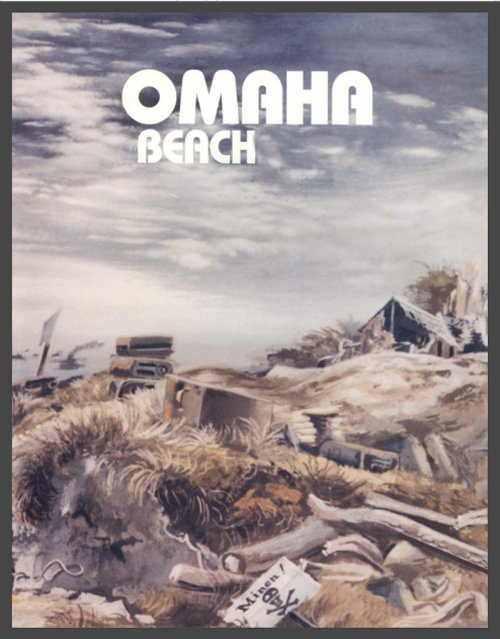 |
|
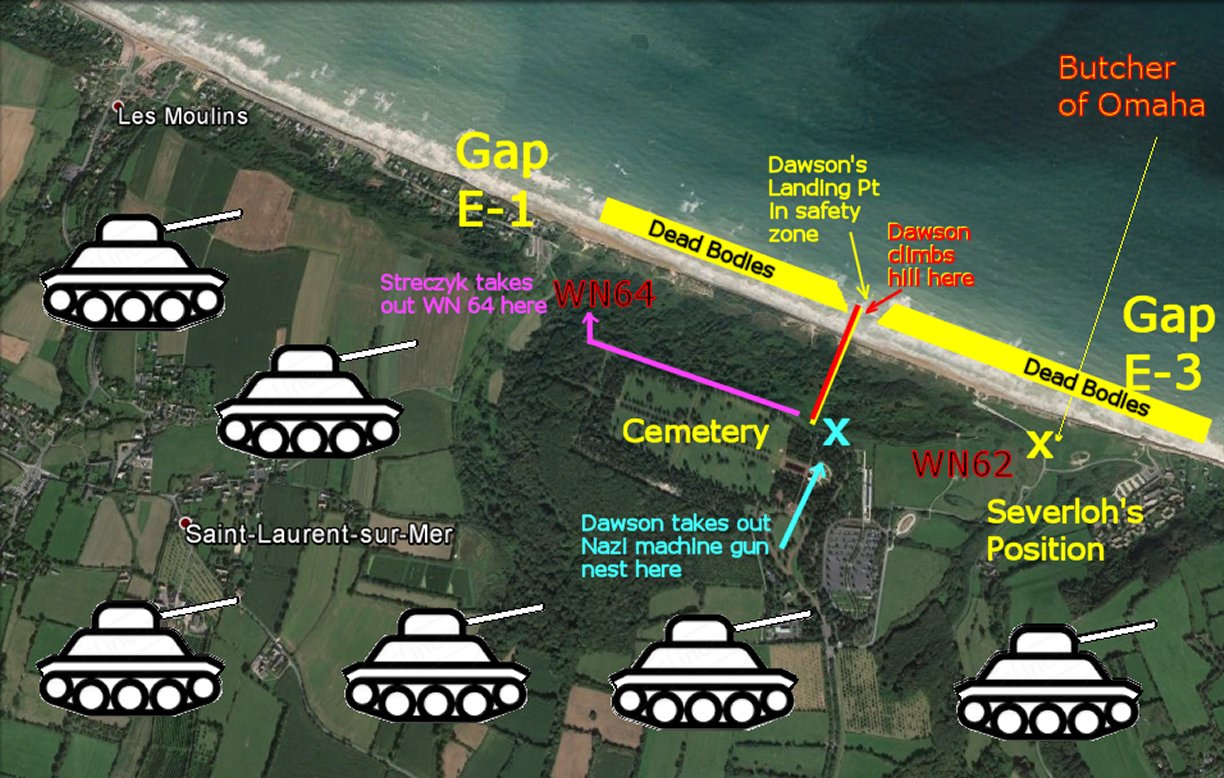 |
To truly
understand D-Day, one needs to understand the
death-dealing tanks
were the most feared weapon by both sides. German
General Erwin Rommel was charged with defending
Omaha Beach. His greatest concern was how to
prevent
American tanks from reaching the French countryside where
they could do extensive damage.
Fortunately, the American tanks could not climb the French
hills, cliffs and bluffs at Omaha Beach. Those imposing hills and
bluffs served as a natural defense against the
American tanks.
The problem for
Rommel were openings known as 'Draws' which
existed 'between' those
hills. In the valleys where small streams
emptied into the Atlantic, these openings were known as 'Draws',
a military term for any valley or gap wide enough to send a tank
through.
Two of
the most important Draws on D-Day were
E-1
and E-3 (see maps above and below, one
facing north, one facing south).
In particular, the
Americans coveted E-3 because it was 600 yards wide.
If the Americans could knock out the German defense
at E-3, their tanks would have all the
room they needed to penetrate into the French
countryside. The strategists decided to
concentrate their attack on the gap at E3.
However,
Rommel knew this was a likely strategy. Anticipating the
attack would hit this spot, Rommel devised a very
effective defense. In particular, this is
where Rommel positioned Heinrich Severloh's machine gun.
Severloh was point man for the defensive position known as
WN62. In other words, since
E-3 was the most valuable spot of the day, 1,000
Americans met their death because they were ordered to
directly attack this position.
|
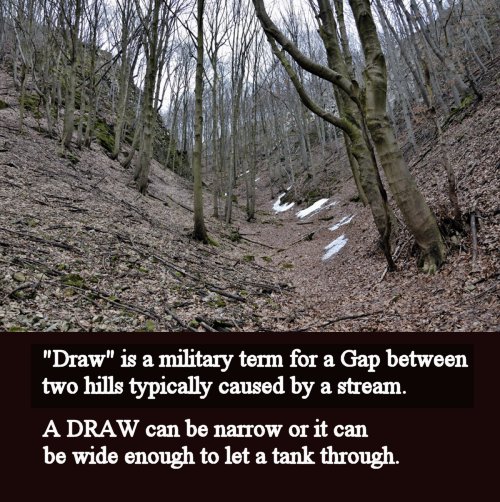 |
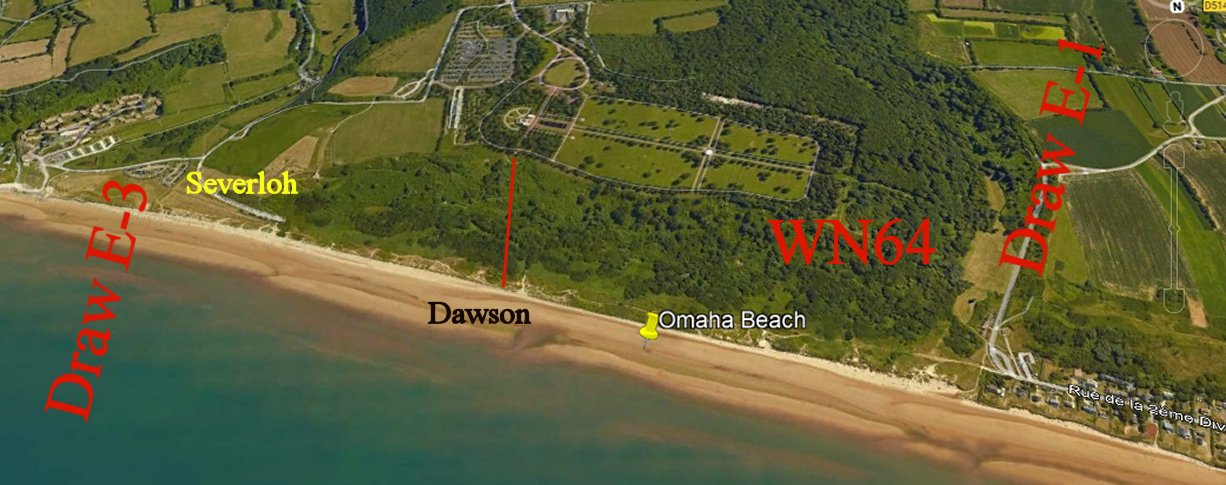
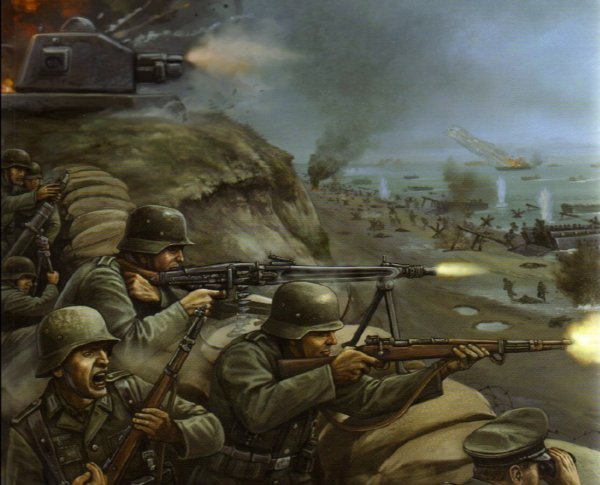 |
In the map
above, take note where Severloh was positioned. Heinrich Severloh, nicknamed the 'Butcher of
Omaha', is said to have personally gunned down
1,000 American soldiers from his dominant view of
the landing area.
In his memoir,
Severloh related that he was located in a concealed position
on the eastern side of the beach along with 30 other German
soldiers. He recalled watching the horizon turn black
with dozens of ships and landing craft racing for the shore.
His commanding officer had told him not to open fire until
the enemy reached knee-deep level in the water.
When the time
was right, Severloh slipped the first belt of ammunition
into his MG-42 machine gun and opened fire. Many men
died before they even reached the beach. He could see
men spinning, bleeding and crashing into the surf, while
others ripped off their heavy packs, threw away their
carbines and raced for the shore.
Unfortunately there
was no shelter on the beach. Lying face down in the
sand, these men were
sitting ducks. And Severloh had plenty of ammunition...
enough ammunition to gun down 1,000 men. Such was the
futility of the American decision to attack the E-3 Draw
with a direct assault.
|
The
Possibility of a German Counter-Attack
Although the
Germans had many reasons to believe the invasion would take
place in Calais 170 miles to the north, they realized the
Allies could conceivably land anywhere in a 500 mile zone
stretching from Amsterdam in the Netherlands to Brest in
France. Even Norway was considered a possibility. There was no
conceivable way the Germans could defend this entire stretch
given their limited manpower. So they attached
different probabilities to various landing points.
The more likely the probability, the better the preliminary
defenses.
The
Germans understood there was no way to keep the soldiers
from landing. Their idea was not to prevent a landing,
but rather to SLOW THE LANDING DOWN. If their
beachside defenses could keep the soldiers pinned down on
the sand long enough, they would have enough time to bring
their crack Panzer tanks from a distance to obliterate the
relatively defenseless men while they were still vulnerable
on the beach.
Since the
Germans did not know where the Americans would land, they
placed their tanks in a geographic central location near
the France/Belgium border.
Like a free safety in American football who sprints to the
ball the moment the Quarterback throws a pass, the tanks would fly
at lightning speed the moment the Germans were sure of the
landing spot.
In other words,
the Germans were depending heavily on their ability to
counter-attack the Allies. The LONGER
the
Germans could keep the Allies pinned down on the beach, the
better chance they had to defeat the invasion.
The Allies were
well aware of this strategy and were terrified by it.
The possibility of seeing their men annihilated on the beach
by a Panzer counter-attack
was their greatest fear. They based their entire
attack strategy on preventing this from happening.
Normandy had
several advantages for the Allies. In particular, the
beaches of Normandy gave the Allies 20 miles to work with. Omaha
was considered the toughest landing point. Other parts of the beach were much harder for the Germans to
defend. This explains why the loss of life at
the other four attack points - Utah, Sword, Juno, and Gold - was
relatively small compared to Omaha.
Bloody Omaha
Beach would mark the fiercest fight of the day.
|
Erwin Rommel's German Defense
|
The German's
biggest concern was keeping the Allied tanks
out of the French countryside.
That's what worried them the most.
They could deal with paratroopers and random
infantry incursions, but the tanks running
free could cause real trouble. The
Germans were determined
to prevent all tank
penetration.
Fortunately for the Germans, Omaha Beach
gave them a tremendous defensive position.
The hills made penetration by American tanks
into the French countryside virtually
impossible.
|
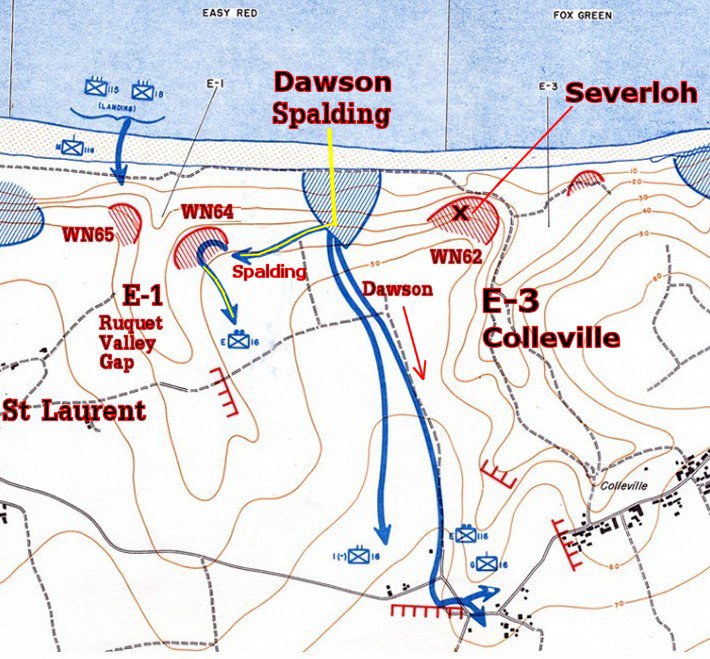 |
Since
the beach was overlooked by huge bluffs and cliffs,
the Germans knew that no American tank could climb
these obstacles.
That
meant the tanks would be forced to use the
narrow valleys. Therefore all the Germans had to do was defend the
valleys between the hills.
Accordingly, the Germans placed their most
formidable defenses on both sides of every valley.
These defenses were called
Widerstandsnester, or 'resistance nest'.
'WN' is the abbreviation.
The
largest gap was known as the Colleville Draw,
E-3
To protect it, the Germans built their deadliest strongpoint
known as WN62
|
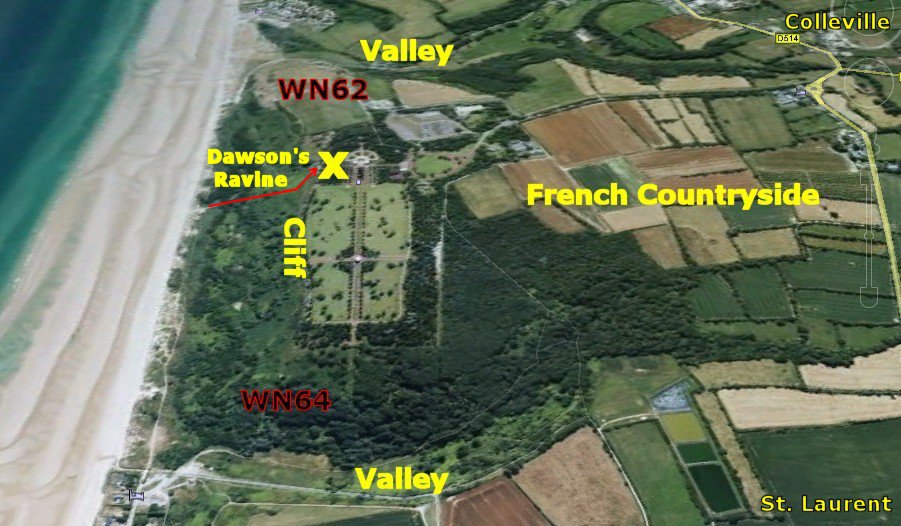
Using
this modern-day Google Earth image, we can see two of
the valleys. The valley on the top was known
as the Colleville Draw, E-3. The lower valley
was known as the St. Laurent Draw, E-1.
Please note the
Yellow
X
. This point marks the Viewing Platform, a lookout point
located at the Normandy Memorial. This 'X' also marks the point of
Dawson's first
American breakthrough on D-day.
|
Heinrich
Severloh was the German soldier who had control of
the dominant position overlooking the
beach at WN62. Thanks to him, WN62
would become a Killing Field at Omaha Beach.
As
previously noted, Severloh, the
so-called "Butcher of Omaha", is said to have personally
killed 1,000 American soldiers during the Allied assault.
There is much circumstantial evidence to believe his claim.
So why
was Heinrich Severloh so effective? I hate to
say it, but the American strategists were largely to
blame.
The
American's worst nightmare was the fear of being
caught by the Panzers while stuck on the beach. This
fear made the battle planners fixate on removing
those powerful defenses as quickly as possible.
The American strategy called for an
all-out assault on the German WN strong points to
gain control of a 'Draw' as fast as possible.
As we recall, a 'Draw' was the military term for the gaps between
the hills, i.e. the points where small streams had
cut holes in order to reach the ocean. This
concept set up a
deadly contest centered around control of the Draws.
American strategy sent men
directly into the teeth of the German defense.
|
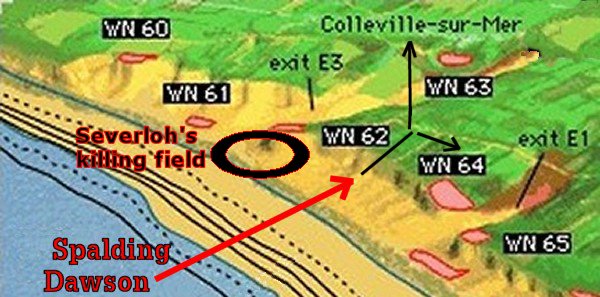 |
Would
the Americans break through fast enough to establish their tanks
in position to retaliate the
vaunted Panzer counter-attack? Or would the German
defense hold the Americans on the beach long enough
for the German tanks to arrive and mow down the
remaining
defenseless men?
As we
now know, the
initial phase of the attack was an unmitigated
disaster. The few men lucky enough not to have
been hit immediately were pinned down on the beach with their
faces in the sand. Unfortunately, as General Omar
Bradley later explained, 'Retreat' was impossible
for the men pinned down. To stand up invited
certain death. Their
only hope was that someone would find a way to knock
out a WN unit and save them from the
deadly fire before the German tanks got there.
The sooner the
American tanks could begin to operate in the
French countryside before the Panzers appeared, the
safer their men would be. With this in mind, the
Americans
wanted desperately to take control of one of those
valleys as quickly as possible. This explains
the suicidal preoccupation with a frontal
attack on WN62 guarding the coveted Draw E-3.
In
hindsight, it becomes clear that the weakest part of
the German defense were the hills themselves, not
the Draws. Therefore the correct plan would
have been to climb the hills and take down the
WN strong points from behind. But that
is easy for us to say, yes?
In
defense of the planners, they probably had no idea
how weak the defenses were on the bluffs.
In all fairness, it is
unlikely they had adequate information to
make the better choice. Forced to operate blind, the
American strategists made a poor decision. They planned to send soldiers directly at the WN
strong points.
|
The
Americans targeted the Colleville Draw,
E-3, as their primary target.
Since the Colleville
Draw was the widest gap of all the "draws", the
American strategists assumed it was the logical
place to start.
Unfortunately, there was absolutely no protection in
the water or on the beach for these men.
This is
why Severloh was so effective. With his gun
controlling an unusually wide stretch of beach, he
shot down one brave young man after another who
tried to attack WN62 head-on.
|
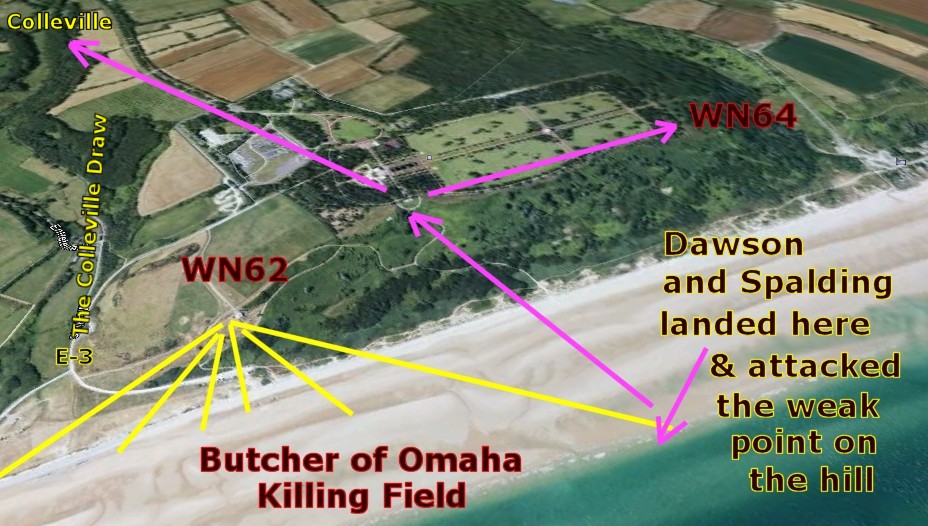 |
Give Erwin Rommel some credit. The Americans
fell right into Rommel's defensive trap by
going directly at his strongest position.
It was Rommel who was responsible for those
1,000 deaths.
All the Butcher of
Omaha had to do was reload and keep shooting.
Obviously the American strategy was wrong.
This was a futile effort. In hindsight, rather
than send their men into a hail of bullets,
the planners should have identified
the weak points and attacked there
instead. As it
turned out, it was Dawson's indirect attack at a weak point
halfway between WN62 and WN64 guarding the
beach and valleys
that saved the day.
The defenses between the WN strong
points were nowhere near as imposing as
those concrete bunkers with powerful
long-range weapons.
What a shame there was no way to study the German defenses
closely enough to realize this ahead of
time.
It was all a guessing game.
How much leeway did Captains like Joe Dawson
have to change his orders? Good
question.
It is said the genius of Napoleon
was his willingness to allow his field
lieutenants
the liberty to make decisions instantly on
the field of battle rather than send
messengers to ask for permission.
Napoleon believed no enemy could be
predicted completely, so he gave his leaders
free rein to adapt to any unexpected
situation as it developed during battle.
Perhaps the spirit of Napoleon infused the
Americans on the battlefields of France's
beaches. American ingenuity in the
form of Joseph Dawson was about
to save the day.
|
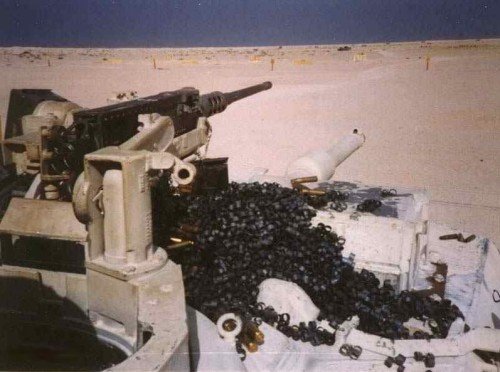
This is said to be a picture taken after the
battle. Take a look at all the empty shell casings
piled up at Severloh's position. That is quite a gruesome image.
|
Dodging the
Kill Zone Triangle
|
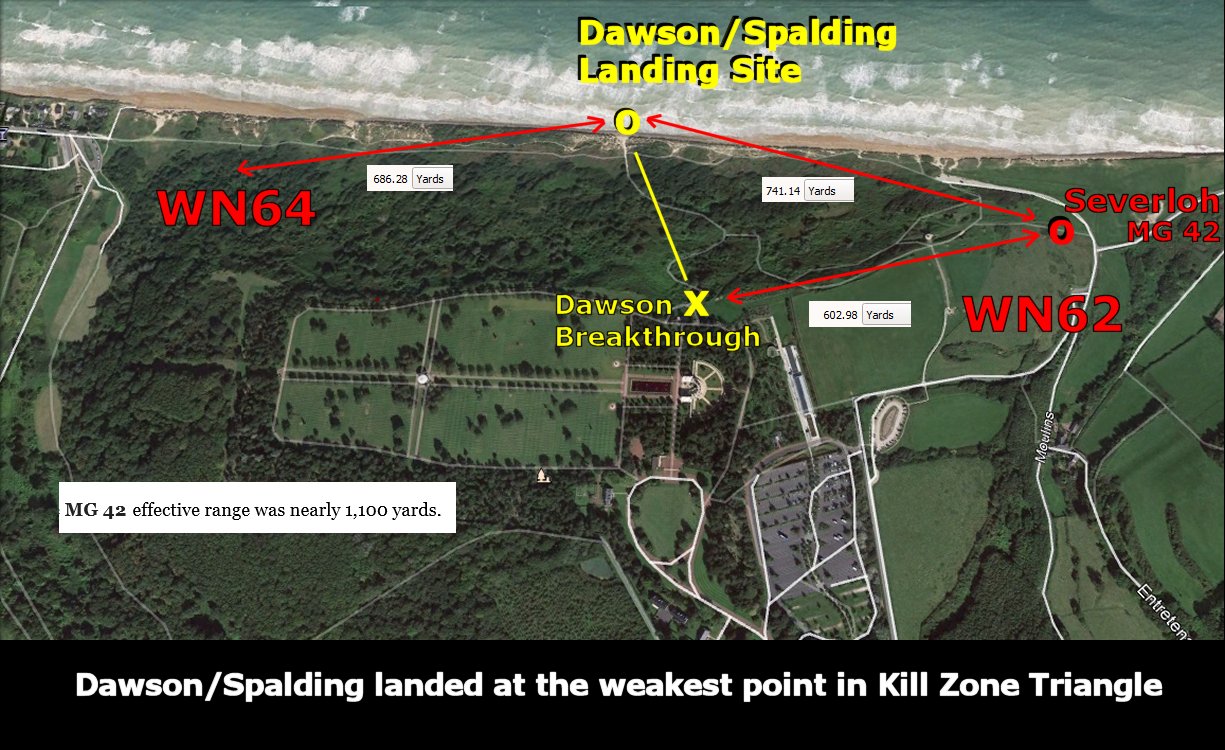
Erwin
Rommel used a Triangle to create the Omaha Beach
Kill Zone. The powerful German MG-42 machine
gun could effectively reach up to 1,100 yards.
By placing an MG-42 machine gun unit in WN62 and
WN64, Rommel created a withering crossfire.
In addition, he placed smaller machine gun units
directly in front of the beach.
Machine
guns can reach a long way, but even these deadly
weapons have their limit. Spalding and Dawson
landed at the weakest point equidistant from both
MG-42 units. They were roughly 750 yards away from Severloh's gunfire
at WN62 and the less dangerous fire
from WN64 on the other side.
The companies of
Captain Dawson and Lieutenant John Spalding
landed at the same spot on the beach about 15
minutes apart. These units got lucky in
several ways. As it turned out, something was
wrong with the machine gun in WN64.
There are two possibilities. One, there are
reports that work on WN64 may not have been
complete on D-Day. Two, WN64 was built
into a cliff amidst heavy forestation. Unlike WN62
which had the trees removed to provide an
unobstructed view of the beach, WN64
had been deliberately concealed inside the existing
forest. Perhaps the
heavy forestation limited the sight lines to the
right side of the unit's machine gun.
There
was also a strong possibility that a machine gun
nest directly in front of Spalding and Dawson's
landing spot was either unmanned or had been
eradicated earlier.
"We walked on across the beach because nobody
stopped us. I was curious why there was no
MG (machine gun) fire to speak of. Someone
pointed out a pillbox on the hill facing us that
didn't seem to be in operation. It doesn't hurt
to be lucky." -- Lt. John
Spalding
Consequently Spalding and Dawson's units were placed in
perhaps the only spot in the Kill Zone Triangle that was relatively free of
the WN62 and WN64 crossfire.
|
| |
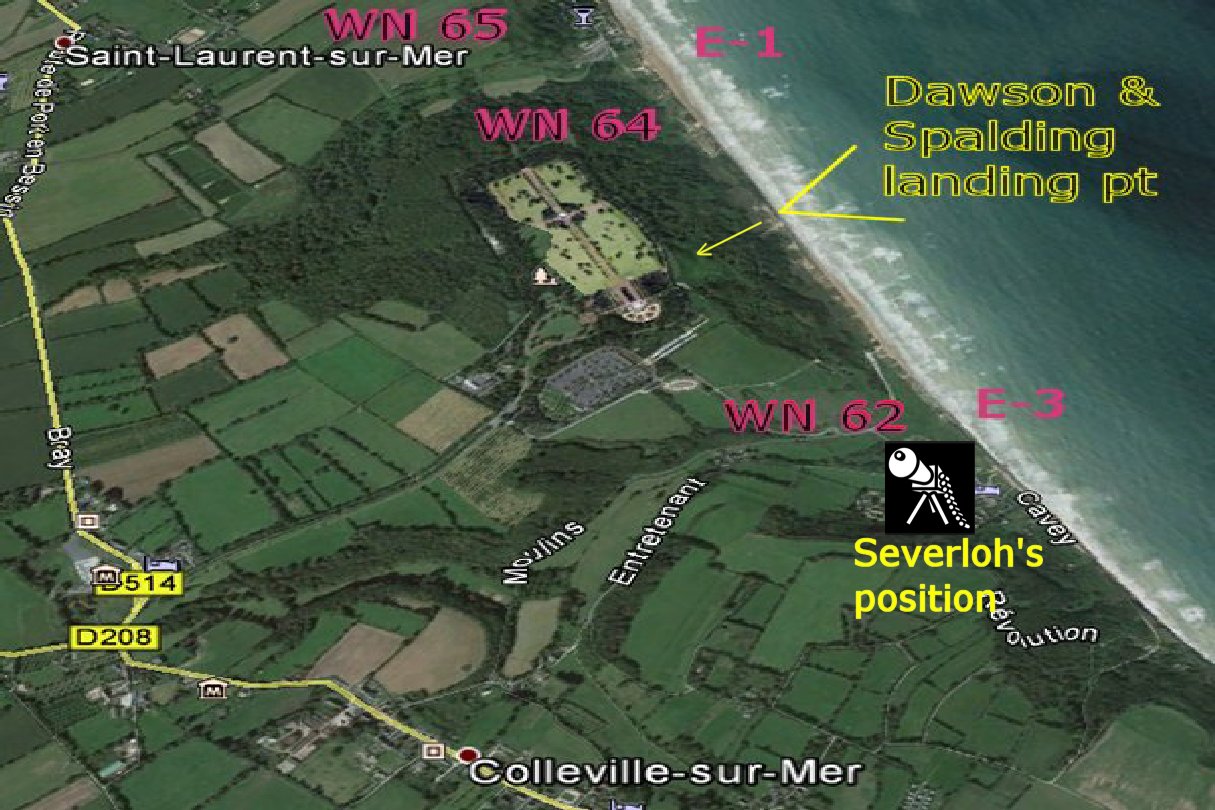 |
Dawson's Company G
was part of the second
wave at the Easy Red sector.
Dawson's
unit landed
just barely out of range of the
Severloh's deadly gun. More than likely,
Severloh's gunfire landed ten feet away.
In addition,
Dawson and Spalding were also out of range of WN64, the other strong point defending this sector. This stroke of
fortune meant these two units would not be pinned down
in the sand like all the rest.
Yes, there were
machine guns defending from higher up on the hillside, but they were not as
powerful or long-reaching as
Severloh's weapon.
Dawson's men
probably didn't know how lucky they were. By landing on the only spot
on the beach where the German
gunfire wasn't nearly as heavy, the company had no
bullets to dodge to cross the beach to safety.
|
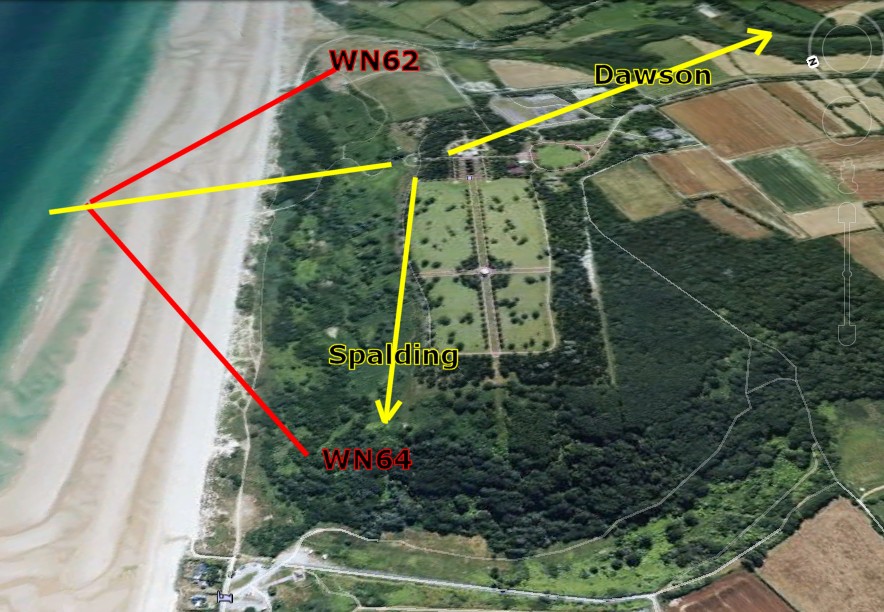 |
Decision to
Improvise
Once Dawson got
his men across the beach, he took stock of the situation.
His orders were to attack the German strongpoint WN62
located 700 yards to his left.
Dawson
could see dead bodies strewn everywhere. In addition, there
were living men on the beach to his right and left pinned down by
heavy fire coming from the WN62 and WN64 Kill
Triangle. Those men weren't going anywhere.
Dawson shook his head. Right or Left, not a good idea.
Dawson turned
his gaze to the hill in front of him. He was facing a
ravine which afforded him protection from Severloh. At the top of
the hill, the incline became very steep, almost cliff-like. However, up the hill about 350
yards away there was an unusual gap in the incline that made
this particular approach seem more accessible. (see
picture below).
|
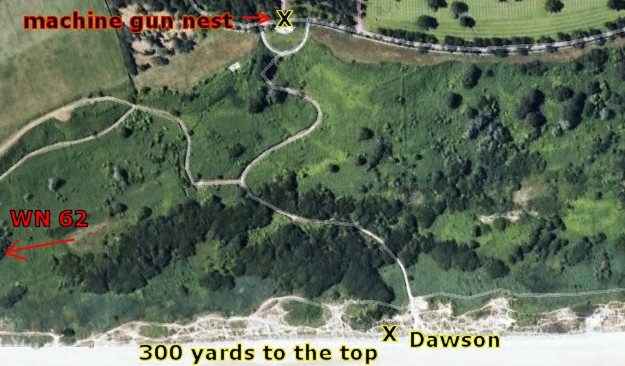 |
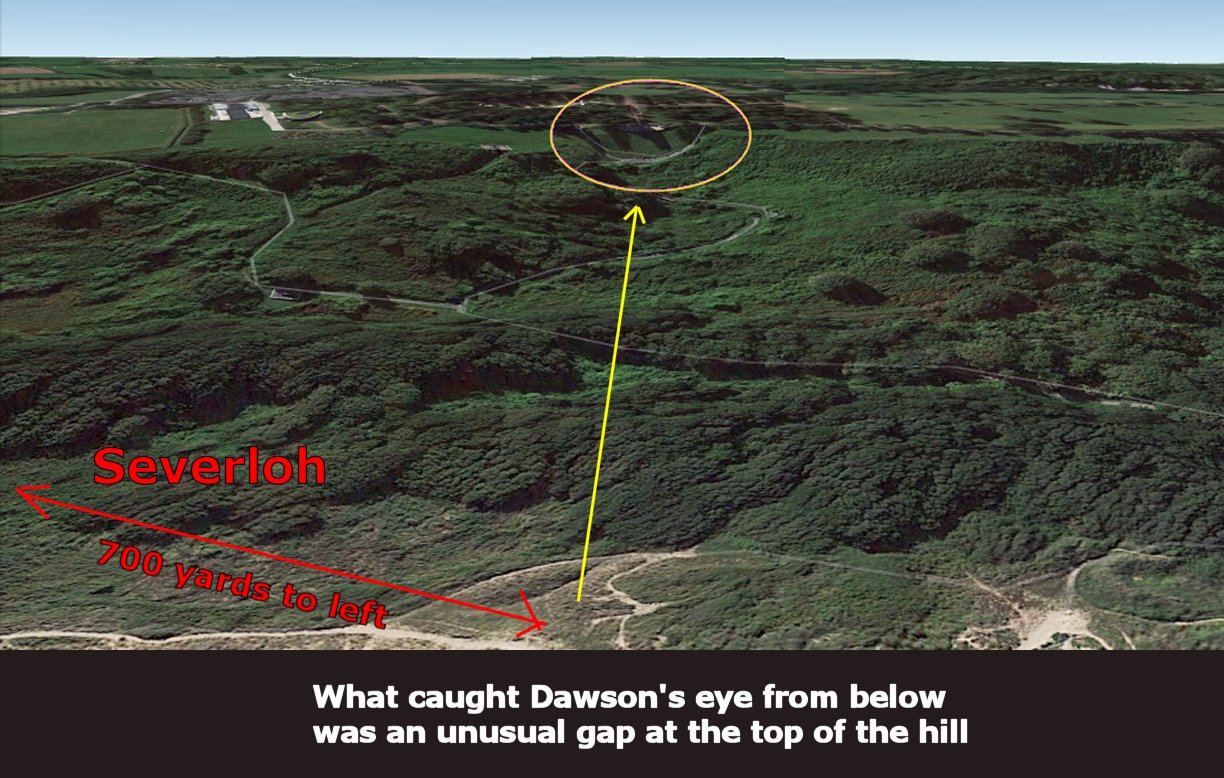
Dawson studied the hill in front of him. The
distance to the top of the bluff was 300 to
400 yards. The crest of the hill was
about 200 feet high with an incline that got
much steeper as one neared the top.
The slope of the hill was about 25
degrees
near the beach. It became steeper
in the middle at 40 degrees. Right at top, the slope appeared to be
75
degrees,
almost cliff-like. Dawson's men would
have had great trouble climbing that cliff...
except for that
inviting gap at the top.
Dawson noticed the gunfire coming
down from the hill directly
in front of his company wasn't nearly as heavy as
he had expected it to be. Why was the gunfire so much lighter here?
In hindsight, it turned out Rommel had
limited resources for defense. His main objective was
not to stop the attack cold, but rather to slow it down long enough
to get his Panzers here to slaughter the men who were pinned
down on the beach.
Rommel knew that no tank could climb these
steep bluffs. Once he reinforced the
'Draws' with extra weapons, he decided
that barbed wire, mine
fields and a limited number of machine gun
nests and snipers would be sufficient to defend the
hills from any attack not supported by
tanks.
What a shame it was that the planners did
not know about Rommel's gamble in advance. Dawson's orders
may have said to attack the strong
point WN62, but Dawson thought otherwise.
This particular hill was a very inviting
target.
What should he do?? Follow his orders
or follow his instincts?
150 years earlier Napoleon had given his
leaders carte blanche to adapt to unexpected
situations in any manner they saw fit.
Today that is exactly what Dawson did as
well. To him, it seemed like suicide to attack Severloh's powerful machine gun
head on. Instead of
attacking the WN62 beach gap directly as planned, Dawson
decided to improvise. He chose to go
directly up the hill
rather than send his men to certain death.
Dawson noticed there was a gulley in
front of them that turned into a natural bowl at the top.
This proved to be another advantage because
the nearby
WN62 stronghold
was completely out of sight. This
meant Dawson only had to deal with the
thinned-out German defense in front of him.
The lower terrain in front served to funnel
any climbers directly towards that gap at the top. There
wasn't much cover going up the hill. The
Germans had completely cleared the shrubbery the
previous Fall. Fortunately, in the spring at least some
cover had
recently grown back. Thank goodness.
However, Dawson still had serious
problems. For starters, where were the
minefields? Finding and crossing the
minefields would be a huge problem.
|
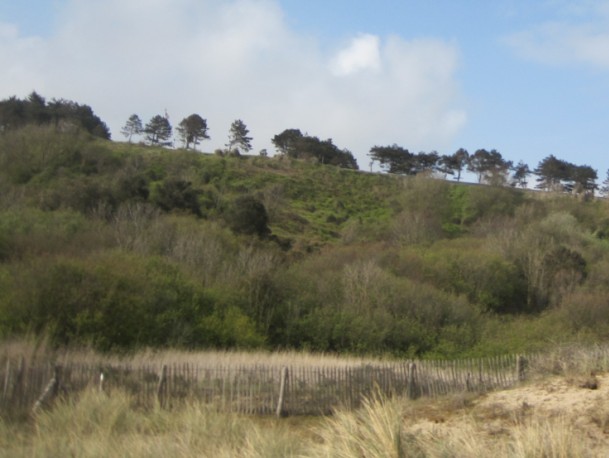
Rick Archer's Note: Here are pictures
I took during my visit.
The Cemetery is behind those trees at the
top. This is next to the spot where
Dawson began his climb. Keep in mind
that the vegetation had been deliberately
trimmed back by Germans. There was
little cover.
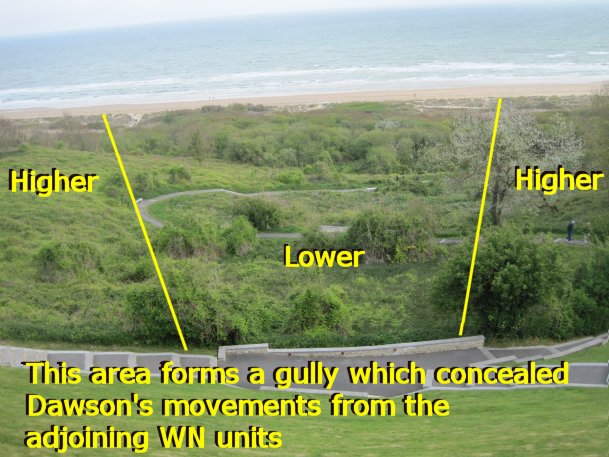 |
Another problem was the powerful machine gun
nest situated at the top of the hill.
In addition, there seemed to be gunfire from hidden
points dug into the middle of the hillside.
More than likely there were snipers posted.
No one could see where the fire was coming
from since these nests were hidden rather
than
fortified. Rommel had decided that hiding the guns
would be just as effective. Each
weapon was certain to have an excellent view
of the terrain below. The Germans
could see the Americans, but not vice versa.
All in
all, climbing this hill would be very dangerous.
|
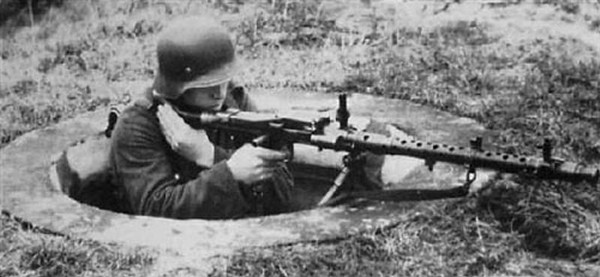 |
It
wasn't easy to defy orders, so Dawson
took one more look to his left.
Those men were
still totally pinned down.
Dawson
made his choice. It was clear that the direct
assault on WN62 wasn't
working. Therefore climbing the hill was
the best option.
These
hills might be able to stop tanks, but what about
his men?
Dawson
decided to find out.
|

The lower X marks Dawson's starting point, the top X
marks the likely location of Dawson's one-man attack
on the critical machine gun nest above. That top X is
beside the Viewing Platform next to the Cemetery.
|
Two dead bodies in the marsh area just past
the beach alerted them to danger. It was a
huge break to know this area was mined
before learning the hard way.
Dawson's first responsibility was clearing a
path. Getting past the minefields
at the bottom of the hill was going to be a
huge problem.
Gruesome as it seems,
Dawson assumed that the ground underneath
the bodies was safe since their death had
likely defused the mine that had killed
them.
Dawson ordered his men to use the bodies as
stepping stones, then stop and look around
for any dangerous clues.
With his men on high alert, they spotted
several mines that the engineers were able
to defuse. It was their good fortune
that the absence of gunfire allowed them to
take their time.
After clearing the minefield, the company
carefully began to climb. One-third
of the way
up the hill, Dawson ordered his men to stop. Dawson made a brave decision. He
took it upon himself to check things out
personally.
Dawson had several reasons. For
starters, Dawson was worried about sending
his men into another deadly minefield or a
hidden machine gun nest. Better to
risk his own neck than send his entire unit
into an unseen trap.
A second reason Dawson went ahead was
to see the terrain with his own eyes.
He wanted to study that opening above.
A third reason to go alone was to employ stealth as he
climbed the hill. Dawson bravely went forward with one other man
beside him. More men would have likely been
spotted.
Clearly Dawson was a gifted leader with a strong
instinct to protect his men. What
happened next was the stuff of legend.
|
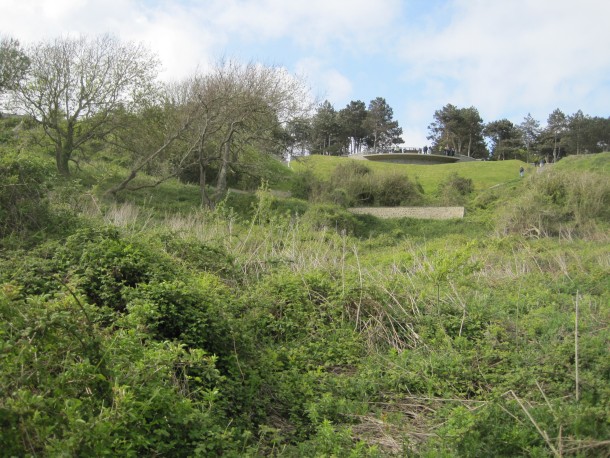
This is a modern-day view of the ravine
where Dawson climbed.
That is the Viewing Platform.
Notice how the bluffs get much steeper right
below the Platform. Once Dawson crawled
to the base where that hill gets steeper, the sharp
angle of the incline probably made him invisible to the
machine gun nest at the top of the hill
where the Platform is. This allowed
him to creep within 30 feet of the gunners.
|
An Excerpt
regarding Joe Dawson from
US Army Military History
(Material is drawn from this
link)
|
The mined areas slowed up every unit that crossed
the beach. Company G,
commanded by Captain Joseph T. Dawson, found
one route through the mines by climbing over the
dead bodies of two soldiers who had been caught
there earlier.
While the company was making its way across the
flat, bothered more by the minefields than enemy
fire, Capt. Dawson
and one other man went on ahead to reconnoiter.
When they were halfway up the hill, an enemy
machine gun at the head of the small draw forced
Dawson into cover behind a dead log. Dawson
sent his companion back to bring up the company.
That is when
Dawson noticed another unit coming up from behind.
Separated by
75 yards,
Lieutenant John
Spalding's section of Company E, 16th RGT, was
climbing the other side of the draw at the same time as Dawson's
company. This unit quickly knocked
out two machine gun placements and took a key prisoner.
Company E under Spalding had been aided in
its advance by
covering fire from Dawson's Company G on the other
side of the ridge. Now it was time to return
the favor. Dawson signaled to Spalding's unit
to provide cover fire on the German machine gun unit
at the very top.
Using the distraction from the ensuing barrage, Dawson
secretly crawled on his stomach
from one patch of brush to another.
By the time Dawson was 75 yards from the gun, the
enemy lost sight of him. Circling to his left,
he came to the crest of the ridge just a little
beyond the machine gun. He was now directly
below the enemy and invisible.
|
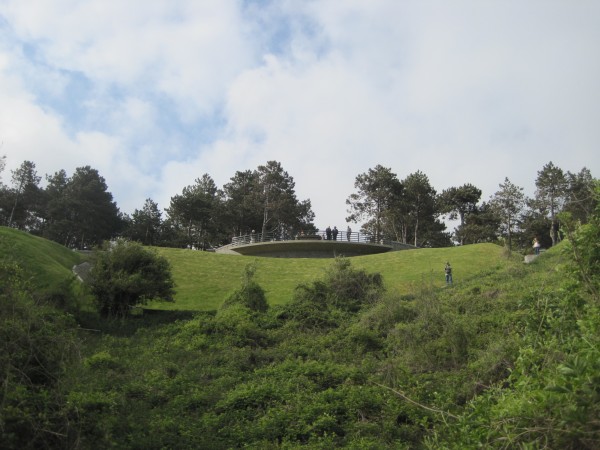
Here
is a modern day view of the ravine Dawson climbed.
The German machine gun nest was situated exactly
where this lookout point is set today or slightly to
the left. Keep in mind this thick
shrubbery was non-existent on D-Day.
|
Moving sideways to the left,
Dawson got within 30 feet before the Germans spotted
him and swung their weapon around. Before they
could fire, Dawson accurately threw a fragmentation
grenade which killed the crew.
This dramatic action had just opened the way up the little draw.
Dawson climbed to the top and waited for his men to
join him.
However it took some time to get Dawson's company up
as a result of disorganization suffered in crossing
the beach flat.
Having eliminated three
separate German resistance pockets on the ravine, men from both companies
completed the climb at roughly the same time.
They gathered at the top of the
hill to plan their next move.
In a conference held at the top of the bluff
with a representative from Dawson's Company G,
Spalding decided to take his men on a totally different route
than Dawson.
|
Spalding turned west along the bluff crest, losing
contact with Company G as Dawson's unit headed south
towards Colleville.
Moving
through hedgerow fields and wooded areas, the Company E
group came up on the rear of the strongpoint guarding
E-1 draw (WN64).
The Germans were manning
trenches overlooking the beach. The American attack from the
forest at the rear of their post caught them by surprise.
In two hours of confused
fighting, Spalding's men got through the outworks of
this strongpoint and overcame opposition by close-in
work with grenades and rifles.
The area opened up by Dawson's Company G and Spalding's
Company E became the major funnel for movement off the
beach throughout the rest of the morning.
(Excerpt drawn from
US
Army Military History.
It has
been paraphrased for 'readability')
|
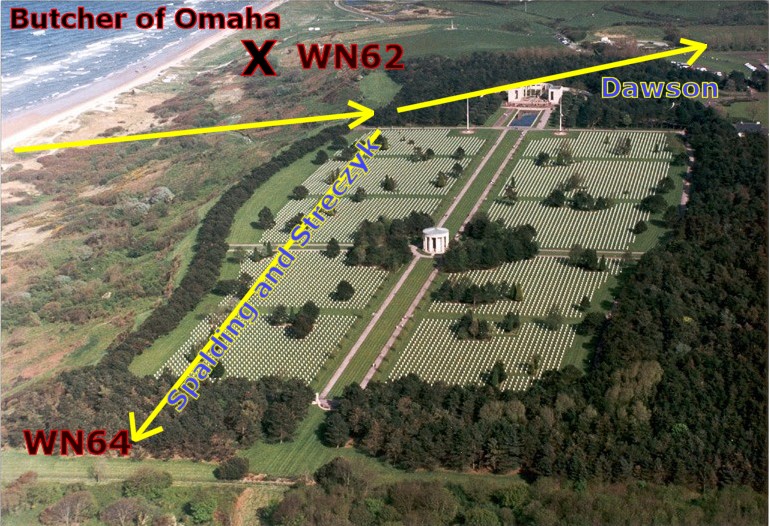 |
Joseph Dawson continued...
Rick Archer's Note:
The
U.S. Military History
excerpt above gives strong hints as to what
Dawson accomplished. However I wish to add more details.
The following excerpt is
taken from Dawson's personal combat journal titled
From Omaha Beach to Dawson's Ridge.
Col. Cole C. Kingseed was the
co-author of this book. Dawson's combat
journal and personal recollections were edited by
Col. Kingseed, the former chief military historian
at the U.S. Military Academy at West Point.
Kingseed succeeded masterfully in capturing the
essence of combat leadership through the actions of
this citizen-warrior.
Before you begin, here is something to ponder.
In Major League Baseball, the
pitcher's mound is 60 feet from home plate.
How would you feel about gambling your life on the
accuracy of throwing a hand grenade at a German
machine gun nest from 30
feet away?
|
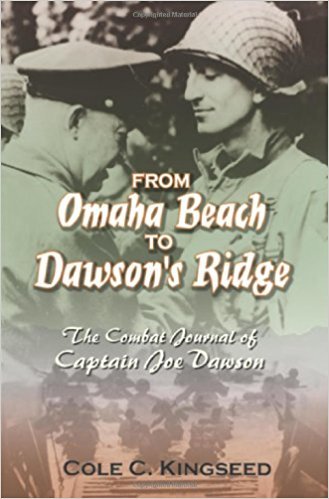 |
From
Dawson's biography:
"Halfway
up the slope, Capt. Dawson and PFC Frank Baldridge found
themselves caught between the fire of their own men
below
and the enemy machine gun nest at the top of
the draw.
Both men dived next to a fallen log for cover. Dawson told Baldridge to leave his equipment
behind and go
back to bring up the rest of the company.
Immediately after that, Dawson spotted Lt John
Spaulding coming up with remnants of his
platoon from E Company. Like Dawson,
Spaulding's company had landed in the same 'blind
spot' on the beach where the gunfire was weakest.
This allowed Spalding to become one of the first officers to
make it across the seawall. His
company
had crossed the beach flat, cut through
barbed wire, traversed the swamp, and
avoided the minefields. Now they began to
climb the bluff.
Spalding's unit was close enough for Dawson
to signal for help.
Directing Spaulding to cover his advance
across open ground. Spaulding's fire
from below distracted the Germans.
When he saw the Germans above duck for cover, he made
his move.
Dawson used the distraction to proceed
closer to the summit.
As Dawson neared the crest, the terrain
changed. Where Dawson had been
climbing a gradual 40 degree slope, now he
reached a ledge just below the crest that
was nearly 80 degrees vertical. Dawson
had reached a point where the Germans could
no longer see him.
As the machine gun busily fired downwards
towards the
beach, Dawson noticed an opening to his
left. Using the concealment, Dawson was able
to circle
around to the side of the machine gun nest unnoticed.
Aware of the danger, Dawson withdrew two
grenades ahead of time and pulled the pins
just in case.
When he was 30 feet from
the machine gun nest, the Germans spotted him at the
same time he spotted them. Instantly
Dawson threw the grenades with their
4-second time delay. Panic-stricken, the
Germans
swung their weapon around to shoot.
It was kill or be killed. If Dawson missed his target,
he would be cut to shreds. Under extreme pressure, he
threw a perfect strike from 30 feet to
take out the
German gunners.
Finally the coast was clear. Signaling
to Spalding below,
Dawson was soon joined by a couple other
men. There were still other German
units operating nearby. Dawson's gunfire kept
the Germans pinned down to pave the way for Company
E under Lt. Spalding to make it to the top of the hill unscathed."
|

One can assume the machine gun nest was
somewhere close to those steps since it
provided the best view of the terrain below.
Although the terrain has been
landscaped and smoothed out, this picture
demonstrates the sharp drop-off that allowed
Dawson to sneak below the machine gun nest
without being spotted.
This is a guess, but Dawson likely circled
to his left below and resurfaced where that small tree
is at the top of the picture. He was able to
get within ten yards before the Germans saw
him.
Panic-stricken, the Germans swung their
weapon around. It was a remarkable do
or die situation. They were about 2
seconds too late.
Please keep in mind that Dawson threw his
grenades from 30 feet away. In other
words, it took a PERFECT THROW to save his
life.
How about that for drama? If
Dawson failed, all those men on the beach
would have remained pinned down.
Dawson's
heroism saved countless lives.
|
Footnote to Joseph Dawson's
Story
|
Rick Archer's Note:
This story has explained how Joseph Dawson
used his sense to override the game plan,
then showed courage and ingenuity to become the first officer to reach the
top of the ridge overlooking Omaha Beach.
His willingness to risk his own life was the
key that opened up this entire area.
His actions were without a doubt heroic and
brave. However, Dawson wasn't
finished. In fact, he was just getting
started.
Once at the top,
Dawson led his men to his
objective at Colleville-sur-Mer one mile
inland. They successfully overwhelmed
the German outpost there. Despite repeated
German attacks, Company G held their highly
vulnerable position at the forefront all day
long. That afternoon while holding
his position, Dawson
was wounded in the leg. Although he
would later be hospitalized for several
weeks, throughout D-Day Dawson ignored his injury
in order to keep his command until reinforcements
arrived late in the day.
Dawson
would earn the Distinguished Service
Cross for his service to America that day. I understand
that the DSC is a major honor, but personally speaking, I don't understand why
Dawson didn't
get the Medal of Honor. Without his fateful
Breakthrough, who knows how many more lives
would have been lost down on the beach?
There were many heroes at D-Day and many
brave men. However, to my way of
thinking, it was Joseph Dawson
above all who rescued the American attack
from the jaws of almost certain defeat.
Joseph Dawson deserves a far
more prominent position in the history of D-Day
at Omaha Beach.
|
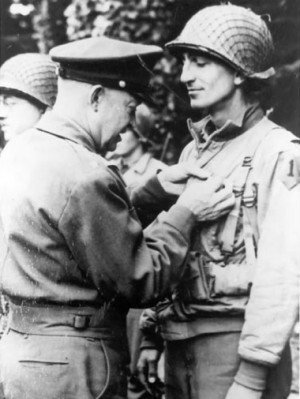 |
Philip Streczyk, the other Unsung Hero
|
Rick Archer's Note:
The term 'Unsung Hero'
applies to many men on D-Day. With the passage of time, the
names of the men who made D-Day a success fade from
memory.
Best remembered
is General Dwight Eisenhower,
Supreme Allied Commander during
this operation. It probably helps that
Eisenhower later became President of the United
States.
Many
people remember Omar Bradley, a
talented General in his own right. It probably
helps that Bradley played a major part in the
Oscar-winning movie Patton.
When
comes Major General Leonard Gerow,
however, that is when I have to drop out of the name
game. I have never heard of Leonard Gerow... and that leads me to my next point...
there are many heroes we have never heard of.
For
example, most of you have heard of war hero Audie
Murphy. And why is that? Murphy played
himself in one of the most famous war movies of all
time, To Hell and Back.
There is
an excellent chance that Joseph Dawson and Philip
Streczyk matched the heroic Audie Murphy
deed for deed, yet virtually no one has ever heard
of either man.
So what
did
Philip Streczyk do? Study the map below. Streczyk took out the resistance unit known
as WN64 virtually single-handed.
|
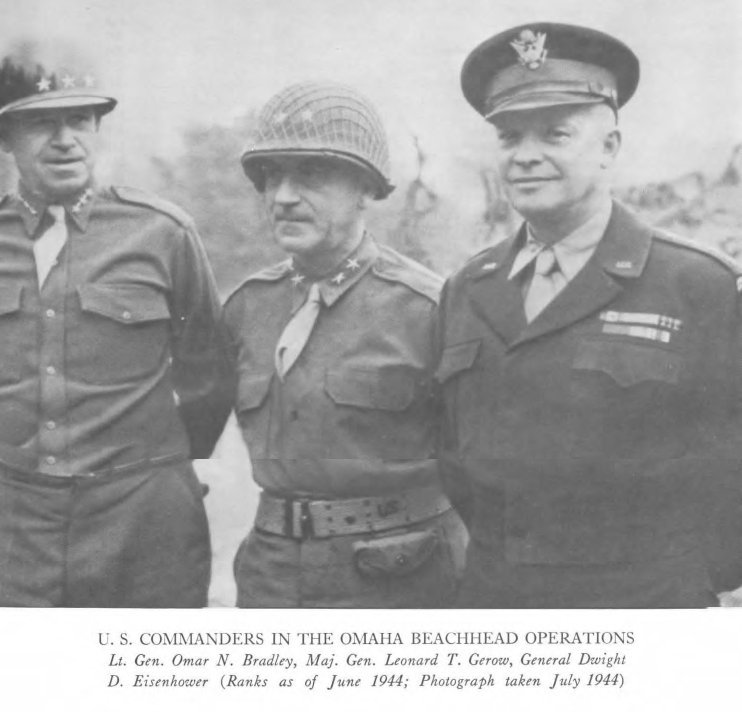 |
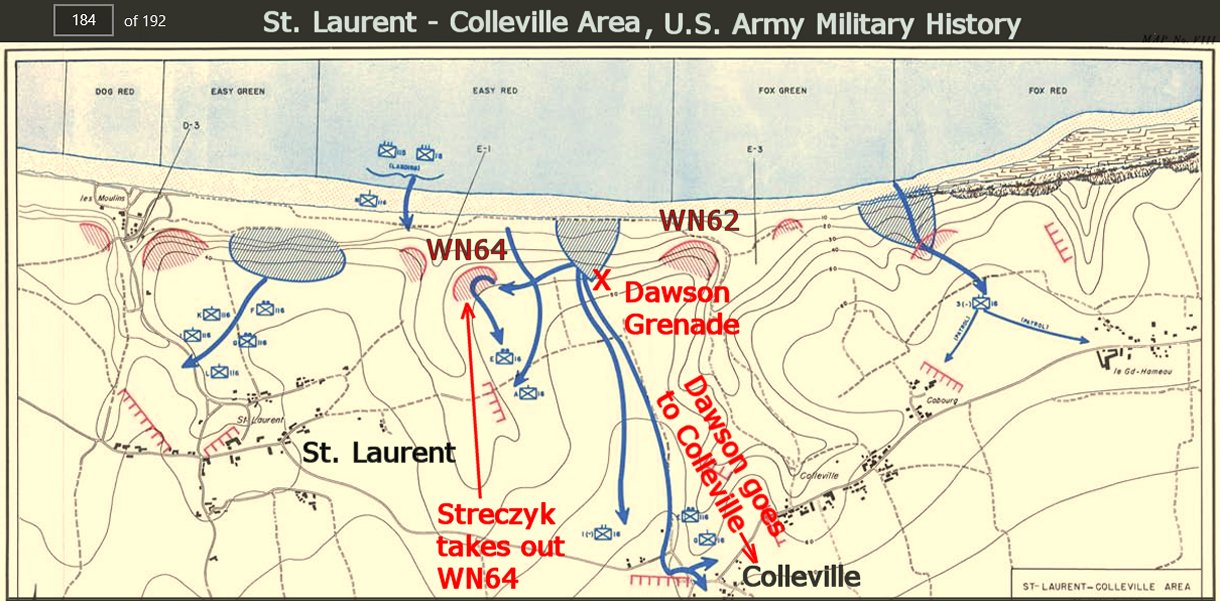 |
Philip Streczyk was a true 'Unsung Hero'.
Let me offer a simple example. The U.S. Army
Military History recap of Omaha Beach contains
the map above. It has 192 pages. In this volume, Joseph Dawson was mentioned 3 times. John
Spalding, leader of Philip Streczyk's unit, was mentioned 8
times. Philip Streczyk was not mentioned once.
And yet the insiders report that Streczyk
practically took out
an entire German Resistance Unit singlehanded via
intense hand to
hand combat.
The
story of Philip Streczyk is
an awkward story to write about. Company
E had two leaders. One was Lt.
John Spalding who was brand new to the unit.
Fresh out of military school, Spalding had taken over in
England just weeks before D-Day. This was his
first command.
The de facto leader of the group was a crack
sergeant named Philip Streczyk who had been with the
men since Africa and Sicily. Streczyk was
like a cobra when it came to fighting Germans.
Tough, brave, crafty, and more than slightly loony,
Streczyk had the kind of guts and fighting skills
reminiscent of Audie Murphy, the famous war
hero. Streczyk
was a leader too. Streczyk's men would follow him anywhere,
and so they did into the dangerous bunkers of
WN64.
Although
Spalding did a creditable job of
leadership, it seems that Streczyk, his second in
command, was the guy who deserved the lion's share
of the credit. However, knowing how the
military works, Spalding's name will always come
first. Is that fair? Well, probably not,
but it is what it is.
After you read my story, it will become obvious who the
real hero
was.
Dawson's action created the
first breach of the day. And
into that breach came another hero, Philip Streczyk.
Streczyk led the charge to eliminate
the first Resistance Nest of the day, WN64.
Together, these two heroes opened the door
for the amazing comeback victory at
Omaha Beach.
|
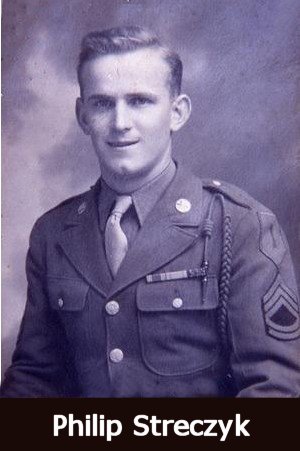 |
Take Down of
WN64 and Subsequent Breakthrough
|
After Dawson cleared out the main defense at
the top of the bluff, Lieutenant Spalding's men were
able to climb the rest of the way safely.
The two units had worked perfectly together
during Dawson's precarious climb up the ravine.
Thanks to teamwork, it was the gunfire of
Spalding's
Company E that
allowed Dawson to sneak behind the machine
gun nest.
Then Dawson and two other men returned the
favor by firing at another position until Company E could make it to the top.
While Dawson
awaited for his own men to
arrive, he sent a man over to confer with
Spalding. At
the conference, Spalding and Streczyk
decided to take their company on a lateral
path across the hill in search of WN64.
Their route took them through a heavily wooded area.
This forest would later be cut down to make room for the cemetery
after the battle.
|
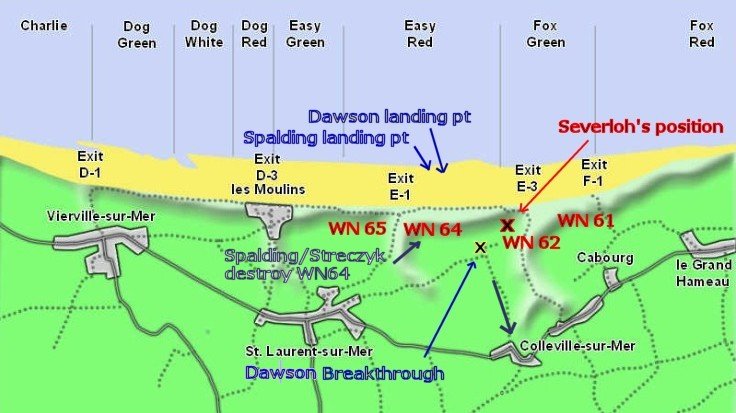 |
To their
surprise,
they stumbled across
Widerstandsnester 64 by accident.
WN64 was
masterfully disguised. Rommel put it
underground on the side of a cliff. The
forest was thick and the WN64 trenches were
cleverly concealed. Spalding's unit had no idea the Germans
were
there until they passed a suspicious air tube
jutting up from the ground.
While conducting surveillance,
Spalding's company heard gunfire. Based on
their position, they guessed they had found
WN64, the German strongpoint that
was guarding the St. Laurent Draw at Exit
E-1.
There was no question they had to attack.
But how? Their small company of 20 was
badly outnumbered by the Germans.
However, they were coming undetected behind the Germans.
This gave them the element of surprise.
Lt
Spalding wisely asked Sgt Streczyk to
lead the attack. Streczyk, a
born fighter, was more than willing to
take the risk.
Thanks to the noise of the
battlefield and the concealment of the forest, Streczyk and his small detachment was
able to sneak up on one underground
bunker or trench at a time.
They would either eliminate the Germans or force them to
surrender.
Then they would move on to the next target.
Amazingly, they were so quick and there was so much
battlefield noise that the Germans never discovered the
American
presence until it was too late.
After brutal hand-to-hand
combat in a half dozen different skirmishes, Streczyk and
Company E finally subdued the Germans.
The
fighting had taken over two hours. The stealth
attack had been a dangerous plan. One
mistake and anyone with an automatic weapon could
have wiped them all out. But it was worth the
risk.
WN64
became the first German
Resistance Unit to fall that day.
The news
quickly got better. Now that WN64 had
fallen,
men
down on the beach were able to use the breach established by
Dawson's Company G and Spalding's Company E to
safely reach
the top of the hill. From there, they snuck in
from behind to put a decisive end to the deadly WN62
defensive position. It took most of the day,
but the
Americans were finally able to interrupt the killing spree
of Heinrich Severloh, the Butcher of Omaha.
Although
Dawson himself did not take out WN62,
it was his ability to put the
gunners at the top out of
commission that cleared the way. Dawson's bravery allowed others to
finish the job for him.
As for
WN64, Streczyk took the baton from Dawson
and searched the thick forest for the hidden
fortification. Although they were badly
out-manned once they discovered the secret location,
the unit courageously annihilated by attacking from the rear
one bunker at a time.
WN64 and
WN62 were finally
gone.
The
irony here is that
neither position was taken using the original planned frontal attack.
Thank goodness Dawson decided to improvise.
|
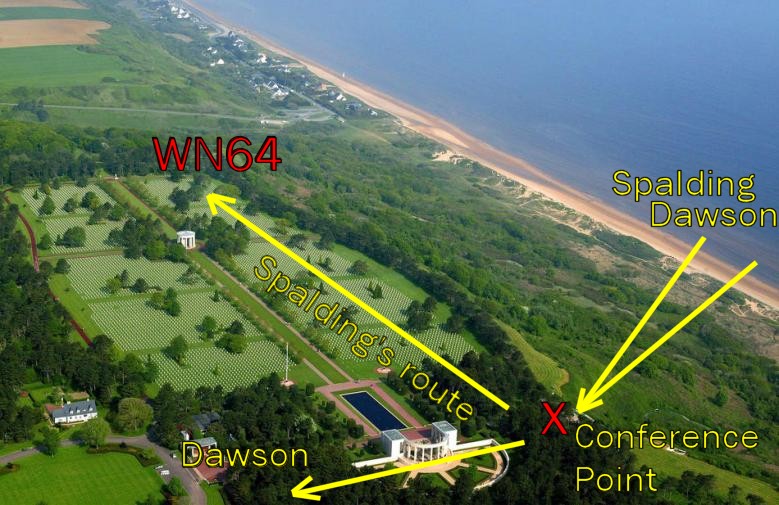
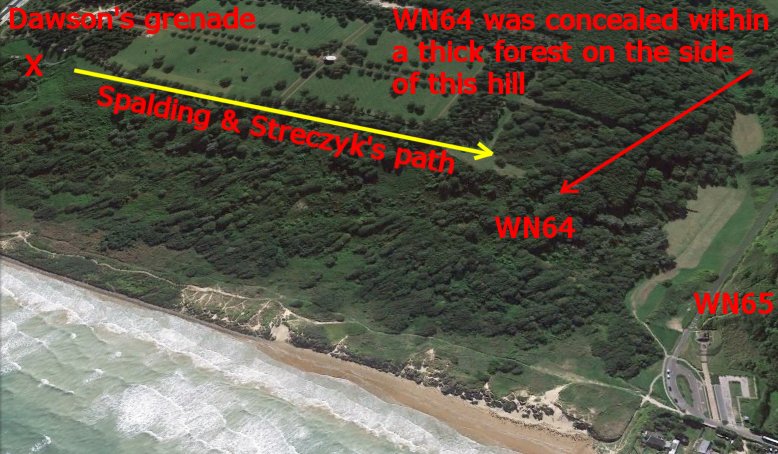
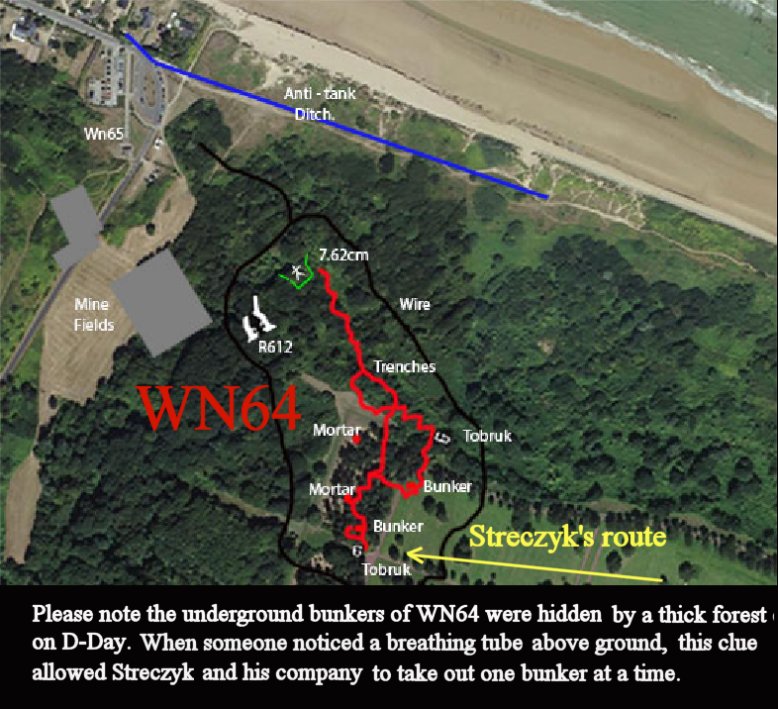 |
Joseph Dawson and Philip
Streczyk had secured the first safe route to the top of the bluff.
Now that this section
of the beach was safe for every man and boat to
land, a steady stream of GIs climbed the hill and
fanned out throughout the day. Dawson and Streczyk had created the
Breakthrough.
The Americans
finally had their objective. With these two
defensive positions subdued, there was finally a
sector on the beach that was safe from enemy fire. The men were not
pinned down any longer. Better yet, two valleys were
now under American control. American tanks began to
roll onto the beach and into the countryside. The Panzer threat was gone.
Rick Archer's Note:
If you ever get the chance to visit
the Normandy American Memorial, be sure to visit the
Viewing Platform shown in the picture on the
right (located at the
Yellow X).
It is fascinating to note the main View Point at the
Omaha Beach Memorial is also the exact place where Dawson's heroic
effort completely changed the course of the entire battle.
This is the spot where Dawson used two hand grenades to plunge
his stake into the heart of the Nazi Empire!
So why is there no recognition? Because the historians have
largely overlooked the dramatic contribution of Joe Dawson.
What bothers me is that no one knows this.
For example, I stood at the Viewing Point listening to a
guide. He didn't have a clue.
Nor are there any historical markers.
We now know a lot of history passed through this very spot
on D-Day. As you gaze out
at the sea and look down at the ravine below, be sure to
remember this is the exact spot where Joseph Dawson made the
first breach of the day in the German defenses.
I think there
should be a
sign or statue at this viewpoint to commemorate this amazing accomplishment.
Perhaps someone
who reads my
story will know the right person to contact to rectify this omission.
A simple explanatory plaque would help visitors learn what
the American heroes did here on that fateful day. They
will be amazed and proud of these men.
It is high
time that Joseph Dawson received more credit for what he did.
And I think another plaque should be erected in Philip Streczyk's
honor where WN64 once stood as well.
In my opinion, Dawson and Streczyk belong right up there next to
Audie Murphy in America's pantheon of war heroes.
(This was written in 2011. Things have improved. In
2018, the Ravine route was renamed for Captain Dawson. It
is now known as 'Dawson's Draw'.)
|
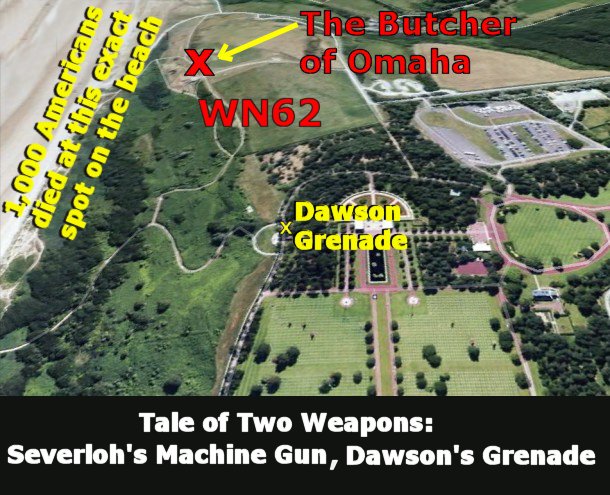
It is no
coincidence the Cemetery lies next to Joe Dawson's
Breakthrough Point.
Dawson went up this hill specifically to avoid the killing fields of WN62.
After the battle, 1,000 bodies lay on the beach
at the footstep of WN62. Consequently the forested area at the top of the hill became
the most logical place to bury the dead.
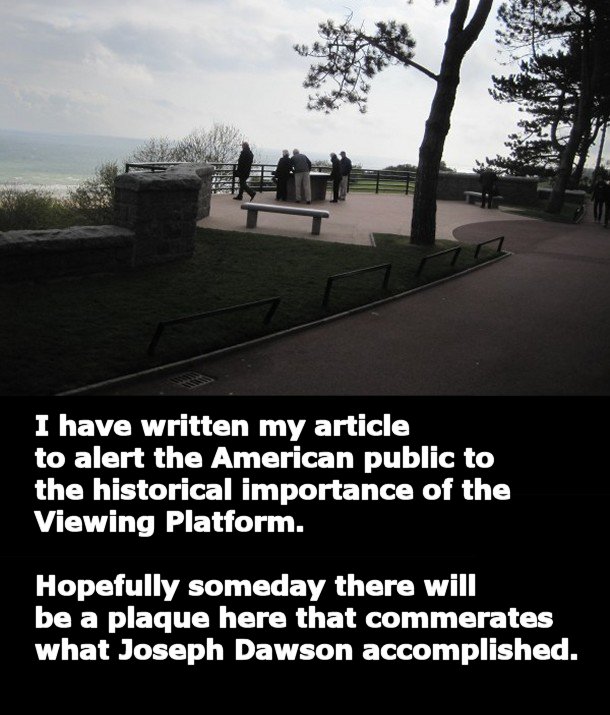 |
The Origin of Rick Archer's D-Day
Story
|
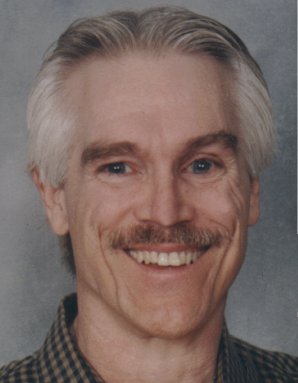
Rick Archer
dance@ssqq.com
|
Rick Archer's Note:
You have just
finished reading the 'Short Version' of my article on D-Day and
Omaha Beach. I hope you are sufficiently fascinated to begin
reading my 'Long Version' of the same story.
I wrote the short version for busy people, but I promise you the
long version is even better.
So how
much credibility does my story have? That is
an interesting question.
For
thirty years, I
owned the country's largest independent social dance studio.
A nice accomplishment, but not exactly the
background one would assume for a battle historian.
(Rick
Archer Bio, contact Rick Archer:
dance@ssqq.com
)
I fully
acknowledge that I do not know a great
deal of military history. Therefore my story
should be a considered a fluke of sorts, an
accidental stumble like finding buried treasure on a
beach. I began
this story as a recap of my visit to Omaha
Beach during my 2010 cruise trip. I thought my friends in our Travel Group would enjoy a brief
synopsis of the story of D-Day after we visited the
location.
All I
intended to do was write an edited version of what happened on that
terrible day at Omaha Beach. However, once I started
my research,
I was much too amazed at what I discovered to stop writing.
So I kept digging around.
My
first insight came when I visited 'John's
Military History'. I do
not know who 'John' is, but he completely
understood the connection between Dawson, Streczyk and that Viewing Platform. In
particular, on his
Colleville page John included a
remarkable picture. (see below)
|
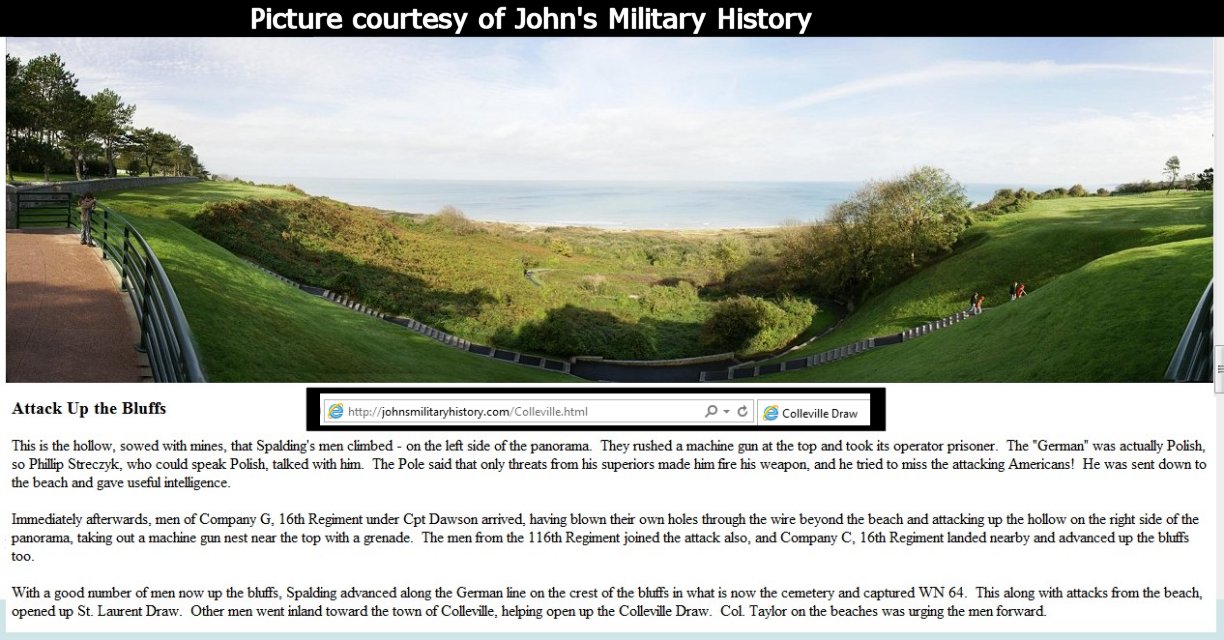 |
In
particular, the moment I saw that picture above, I
realized it had been taken from the Viewing Platform.
I put two and two together and realized I had been standing on the exact spot where
Joseph Dawson had taken out the machine gun nest. Once
I figured that out, I got goose bumps. Now I was hooked big-time.
I began my
project
by re-reading The Longest Day, the famous account of
D-Day written by Cornelius Ryan in 1959. Then I read
Joseph Balkoski's Omaha Beach. Then I
visited Wikipedia for an overview. Then I ran across
Joe Dawson's personal combat journal From Omaha Beach to Dawson's Ridge. From there I began to
comb the Internet for pictures and further information.
Finally I added pictures and observations gleaned from my visit to the
Normandy American Memorial.
As you read my
story, keep in mind that everything I have written was drawn from the writings
and comments of others. Born in
1949, I obviously did not participate in D-Day.
|
| |
Therefore I had no choice but to rely on the tales that I found on the Internet.
If you want to learn more, do the same thing I did - use
Google! Google Internet searches will help you gather
almost all the details you could ever ask for.
My story is meant to be
enjoyed as a fairly accurate short story on the events of
the day. However, I openly admit I may have
misinterpreted some of the things I read, so please don't expect
total
historical accuracy. Furthermore, since I am relying
on the work of other people, I have no way of verifying
their accuracy. That said, my hunch is that my version
is quite accurate.
I wish to
add that I combined elements of different stories to make the
saga more readable. One of the problems of the
different books about D-Day is that they skip around from one story
to the next. I understand why - each book was trying to
tell the complete story.
Omaha Beach
was just one of five beaches at Normandy. There was
also Utah, Gold, Sword, and Juno. Although Omaha Beach
was very dramatic, every single landing point had
amazing stories of its own. The books about D-Day
have no choice but to skip back
and forth between all five beaches.
I wanted to
concentrate on Omaha Beach because that was where I visited. However, I quickly learned
that
Omaha Beach was divided into ten different sectors. Their
codenames were Able, Baker, Charlie, Dog Green,
Dog White, Dog Red, Easy
Green, Easy Red, Fox Green and Fox Red.
I quickly
discovered that every one of these sectors had its own amazing stories and brave
heroes. However, sad to say, there was
no way I could do justice to all the amazing individual
stories of Omaha Beach and keep the length down. For every personal saga I
covered, I was
forced to omit many other equally amazing tales such as
George Mabry and Frank Peregory.
|
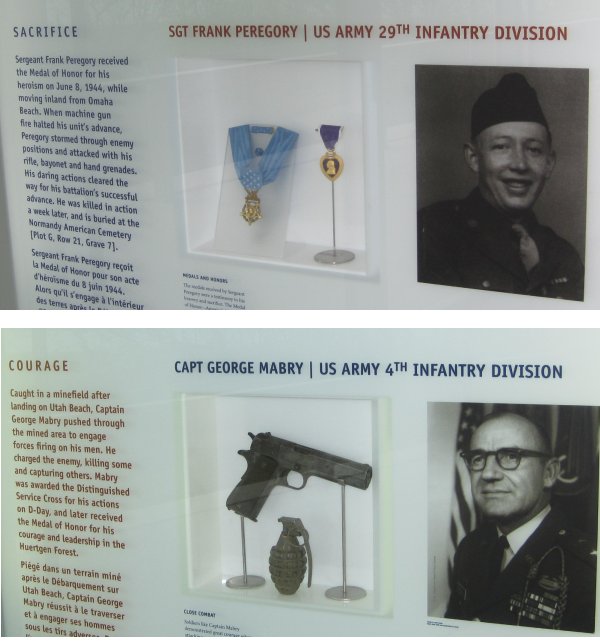 |
|
|
Once I decided
there was no way I could do justice to the drama of ten
different sectors, I chose to concentrate my story on
Easy Red, the sector I had visited. I focused my
story on Dawson and Streczyk, two individuals who did
so many
remarkable things. By taking different accounts
of the same incidents, I wove them together like making a
quilt out of patches.
Let me
add that I found several 'contradictions' in these stories that I had
no way of reconciling.
Therefore I beg that
everyone read
this story with the understanding that this is NOT a 'scholarly work',
but rather a collection of interesting tales that are meant
to give insight into the amazing event.
And now let's
begin the Long Version of my story!
Rick Archer
|
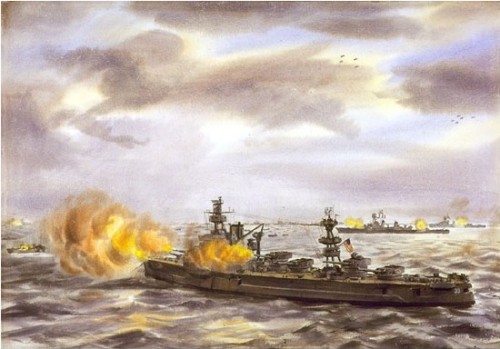 |
|